How the Hensley Hitch Works
- Dealer Locator
800-410-6580
- Sway Elimination Hitches
- TrailerSaver 5th Wheel Hitches
- McKesh Mirrors
- Hitch Accessories
- Hensley Arrow & Cub Parts
- Trailer Saver Parts
- Trailer Sway Facts
- Hensley Arrow & Cub Support
- TrailerSaver Support
- Hitch Articles
- Build my Hitch

Hensley Arrow Anti-Sway Trailer Hitch
A travel trailer outfitted with the Hensley Arrow® gives you:
- Total sway elimination
- A choice of car, SUV, or pickup truck to tow with.
- Tighter 82 degree turning radius.
- Level floor plan.
- Lower trailer cost.
- Lower center of gravity.
- Stress-free towing.
And much more...
- Local pickup from factory
- Ship to a local freight terminal
- Ship directly to your home
Payments as low as $231 month
Easy 12-month financing available. Be sure to ask your towing specialist for more details.
- Solid Steel Construction
- New! Enhanced paint adhesion process
- New! Adjustable Hitch Height Option Available - Ask your towing specialist
- Heavy Duty Jacks & Spring Bars
- Patented Converging Linkage System
- Solid Steel Hitch Bar
- Continuous Sway Elimination
- Improves Steering Over Uneven Roads
- Improved Handling During Braking
- Tighter Turning Radius
- 14,000 Pound Rating, 1,400 Pound Tongue Weight (with proper weight distribution bars)
- 60-Day Money Back Guarantee
- As low as $231 month
Safety The Hensley Arrow® mechanically locks sway out and creates an inherently stable relationship between your trailer and tow vehicle. Uneven road conditions, wind gusts, passing trucks and steep downhill grades can all be handled with confidence. However, common sense and normal safety precautions should always be used. All hitch models and parts are in stock and ready to ship the day you order, shipping from our Michigan, USA production plant to your doorstep within a few days. No waiting days or weeks to fill an order.
Design The secret of the Hensley Arrow® rests in its patented converging linkage design. The Arrow allows movement on the ball in every direction except side-to-side. Side-to-side movement is forced to go through the linkage system which is one-directional. From the trailer side, the linkage is solid. Pivoting by the linkage must be initiated through the tow vehicle. The system’s design is inherently stable. Best of all, it functions mechanically, without the use of friction so it exhibits consistent and predictable behavior regardless of changes in weather or road conditions. Construction The Arrow is constructed with careful attention to detail and is continuously checked to see that the highest quality is maintained throughout the manufacturing process. Made to last as long as you tow. Solid Steel Construction Heavy-duty spring bars and jacks. Tapered roller axle bearings, seated in hardened bearing races, packed with grease, and sealed from moisture.
Hooking up your Hensley Hitch
Hensley Arrow Manual & Cub Manual
Customer Review of Hensley Hitch
How do you properly use weight distribution with a Hensley?
Weight distribution with a Hensley is easy. The weight distribution aspect of the hitch is completely separate from the sway elimination aspect of the hitch.
Even if you forgot to pull up the weight distribution, your trailer will NEVER sway.
When you set up your weight distribution, you are looking for a couple things. You want to minimize the bouncing between your truck and trailer, and you want to have good, firm,positive steering.
Read your owner’s manual carefully for instructions on first setting up your weight distribution. If you use an air lift system in your truck, inflate those first to where you like them to be. Then use the weight distribution to get a good ride.
Questions? Call us at 1-800-410-6580.
How long does it take to install a Hensley Hitch?
Estimated Hensley Hitch Installation Time
On average, the installation can take anywhere from 2 to 4 hours to complete. Learn more here
Can you back up with a Hensley hitch?
Contrary to the misconception that backing up is challenging or even impossible with a Hensley Hitch, the truth is that the Hensley Hitch does not restrict or hinder your ability to reverse your trailer. Learn more here
A perfect safety record and outstanding customer satisfaction
A no-questions-asked lifetime warranty for as long as you own your Hensley Arrow or Cub.
60-day unconditional money back satisfaction guarantee
Dedicated employees who provide world-class customer service 24 hours per day, everyday
Customer Reviews
We pull a 34 foot Airstream and have had NO problems with the hitch. Just finished a 10,000 mile trip this winter, and when towing the trailer, I often forget it is behind my truck. GREAT hitch. Never any issues. FABULOUS support (if needed). Not super easy to hitch up and go... takes a bit of patience, but easy once the tongue is in the receiver... a bit of practice and it is really easy. Other than that, I would not consider any other hitch as I REALLY like the quality and the way the hitch works. We have been thru some REALLY bad in climate weather in all these years with wind, rain and snow, and SURE glad we have the Hensley. It works REALLY well! And it was VERY strongly recommended when we bought our trailer as the hitch could handle the large pull trailer.
Love this hitch design, since my purchase original purchase early 2021. I was pulling my 30’ Airstream without the Hensley and experienced a White Knuckle drive with some sway and that’s when my wife and I decided to Purchase the Hensley no questions asked. Since then we have logged over 40,000 miles with absolutely no sway making traveling a very fun and safe experience. I also teach Airstream newbies on Maintenance and Safety. For safety, among other things, I pitch Tire Pressure Monitoring and the Hensley System. I also mention that design of the Hensley with the Stinger should not be intimidating, yes it does take sometime to learn and understand how to hookup the RV, but once you understand the mechanics you can hitch up faster than the traditional hitch design.
The Hensley is extremely well built, the stinger is all one solid welded piece eliminating a potential point of failure and with Hensley fantastic support you will travel in confidence with no more sway. In the 40,000 plus miles I have traveled I have not experienced any, I mean no sway what so ever. This includes driving up and down the Rocky Mountains, through the gusty winds out west and passing or being passed by large semi’s.
Thank you Hensley!
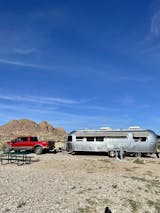
I LOVE the Hensley hitch! - My husband and I have done two cross-country trips with our Airstream and we bought the Hensley hitch for safety reasons so I would feel comfortable helping him drive! We were an hour away from home after going across the country and back, and I was driving - came up to the top of a hill and the traffic was suddenly stopped - to avoid crashing into the car in front of us, I slammed on the brakes and swerved to the right onto the shoulder - then came back into my lane. The Airstream (27 ft) just glided right along with me - when I swerved and when I came back into the lane!! I couldn't believe how well it worked! It was so scary and we got to see firsthand HOW the Hensley provides such safety! LOVE IT!
The Hensley hitch is hands down the best investment/enhancement we have made to our travel trailer. The hitch truly does what it advertises, and eliminates all trailer sway which becomes a game changer in comfortably and confidently pulling a large travel trailer in all conditions.
Let me make this easy for you. This will be short and to the point.
The Hensley Hitch is the finest Hitch made on the planet.
My wife and I and our two golden retrievers. Have a great time in our Ford F150 that pulls our 30 foot trailer from Grand Design.
The Hensley Hitch has given us safe travels through eight states and over 10,000 miles including going over the Rocky Mountains with zero sway!
Added to your cart:
Compare products.
{"one"=>"Select 2 or 3 items to compare", "other"=>"{{ count }} of 3 items selected"}
Select first item to compare
Select second item to compare
Select third item to compare
RV Sway Control Basics for Travel Trailers
By Rob Cochran
When it comes to RVing, sway is best saved for the hammock. Feeling your travel trailer sway from a gust of wind is scary, but there are products and strategies that can help reduce sway and keep your RV aligned.
What Causes Sway?
The most common causes of sway are gusts of wind, drafts from passing semi-trucks, turns on curvy roads, and imbalanced loads in the trailer. Even a small amount of sway can be exhausting for a driver, forcing constant steering adjustments. Weight distribution and sway prevention systems make for a safer and smoother ride.
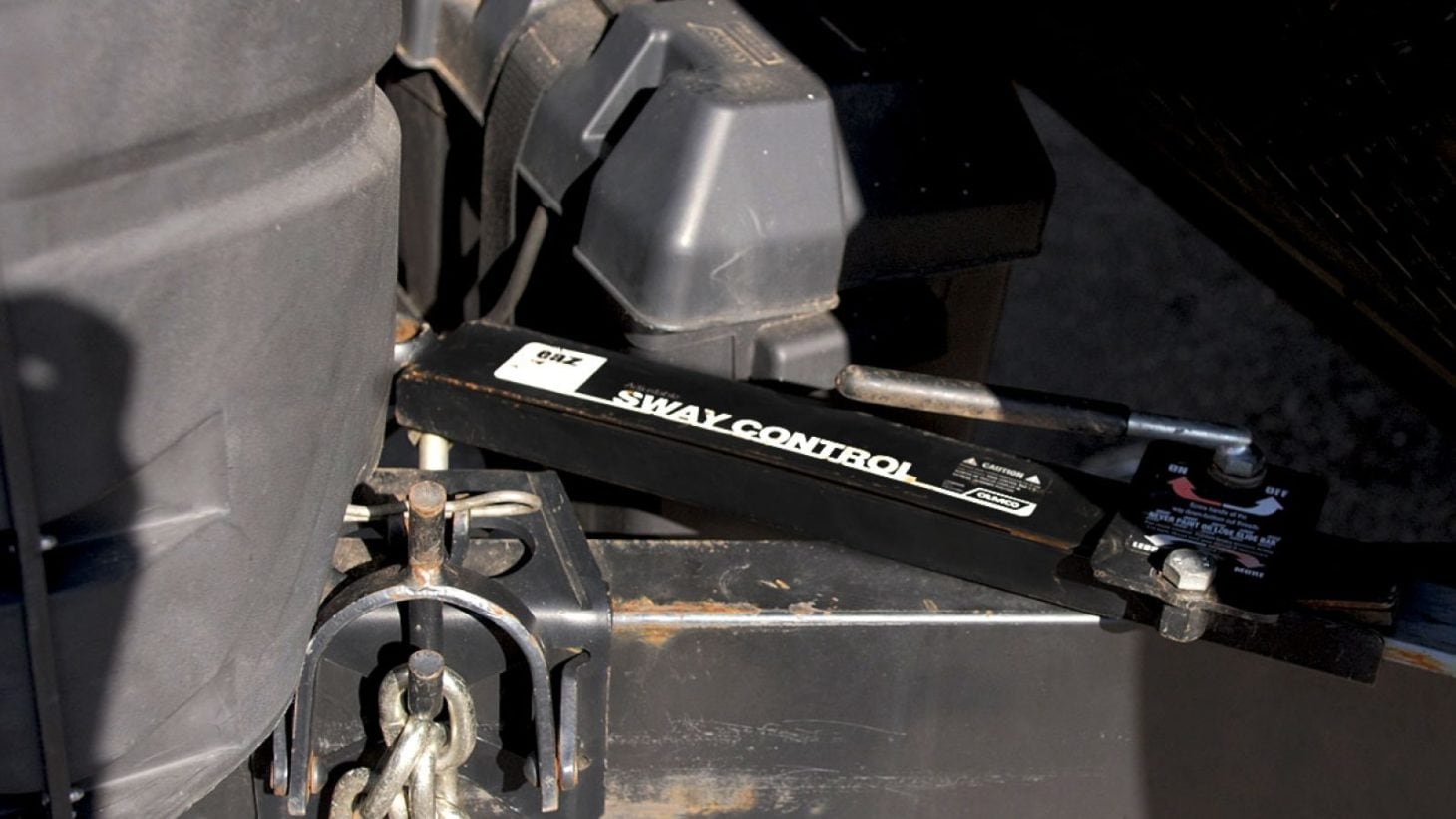
How Can I Prevent Sway?
There are a few simple, practical things you can do to reduce the risk of sway.
- Pay attention to weather conditions. If it’s very windy, it may not be a good day to travel.
- Consider your load distribution. Distribute the weight in your RV evenly from front to back and side to side. Move heavier items to the front if needed. A good rule of thumb is 60 percent to the front, 40 percent to the back. Take into account things like slide-outs and appliances, and make sure you compensate by putting heavier items on the opposite side while packing.
- Check the weight of your loaded RV at a local scale and move gear around as needed. Make sure you don’t exceed the GVWR or GAWR and test after adding propane or water you plan to use during travel.
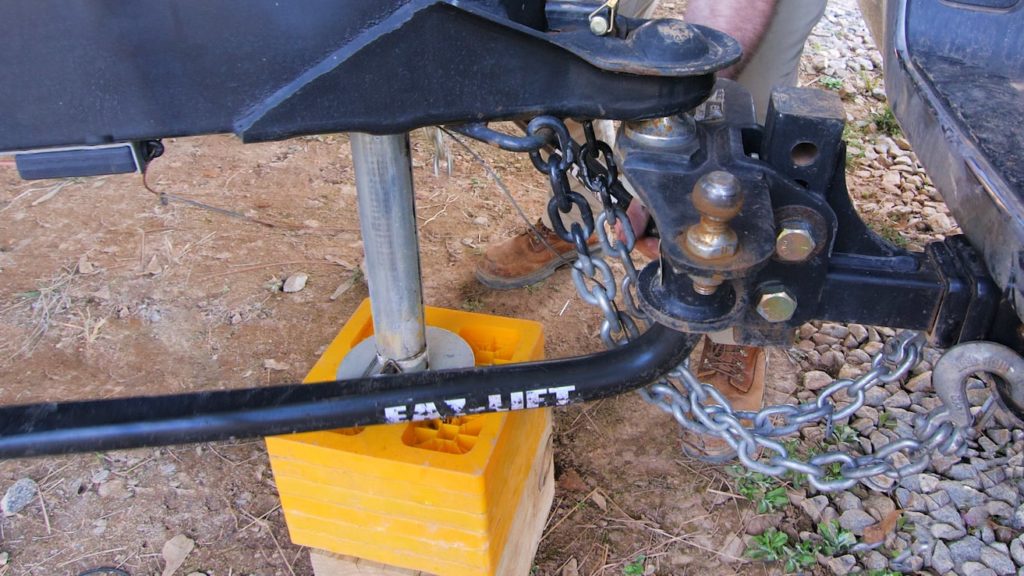
How Do Weight Distribution Systems and Sway Control Bars Help?
Weight distribution systems distribute a portion of the trailer’s tongue weight from the back of the tow vehicle to the front. This allows the tow vehicle to ride more level and have more control because the proper weight will be on the steering tires. Sway controls use a friction type device to prevent the trailer from easily swaying from side to side. There are several common types that all work a bit differently and come at varying price points. Trailer weight distribution systems and sway control bars can be separate components, or in some cases, the sway control device can be built into the weight distribution system. Make sure any weight distribution or sway control setup you purchase is rated to your towing weight and your tongue weight.
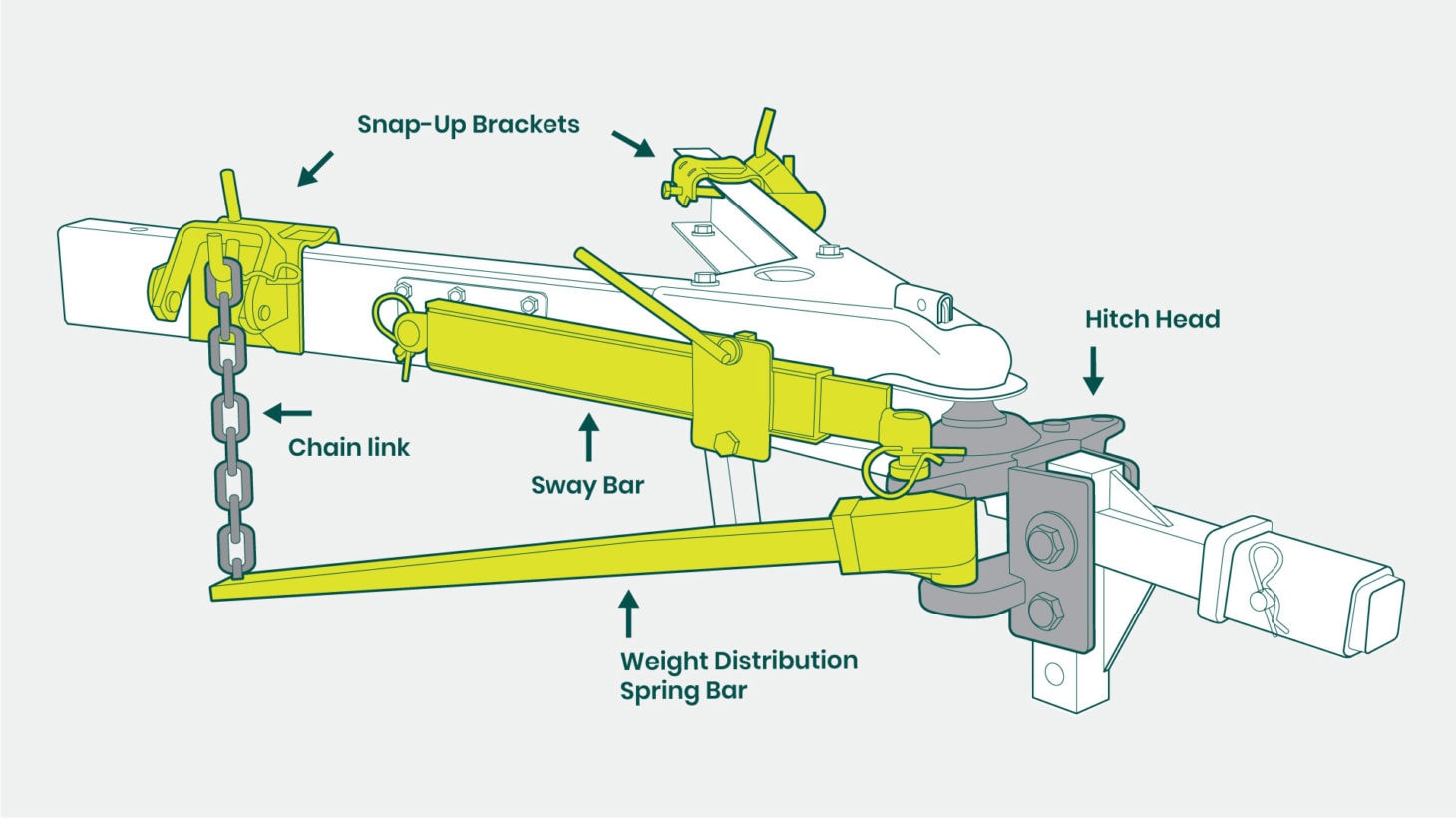
Weight Distribution System
You should use a weight distribution system if your travel trailer is at least 50 percent as heavy as your towing vehicle, or the rear of your tow vehicle sags when the trailer is hooked up. A typical weight distribution system uses spring bars attached to the hitch to distribute the load evenly between the axles on the tow vehicle. The result is a smoother and more level driving experience. Popular brands include Reese , CURT , and Camco .
Another type of weight distribution system uses a built-in sway control feature that adds additional sway protection without adding a separate friction control device. These are generally a little more expensive but can save hook-up time and storage space when not in use. Popular brands include Equal-i-zer , Blue Ox SwayPro , Husky Towing Center Line .
Average Cost: $300 to $700
Dual Cam Sway Control System
A dual cam sway control system is useful for large trailers. It attaches near the hitch and hooks onto either side of the trailer. The cams prevent sway but unlock when the trailer needs to turn.
Average Cost: $300 to $500
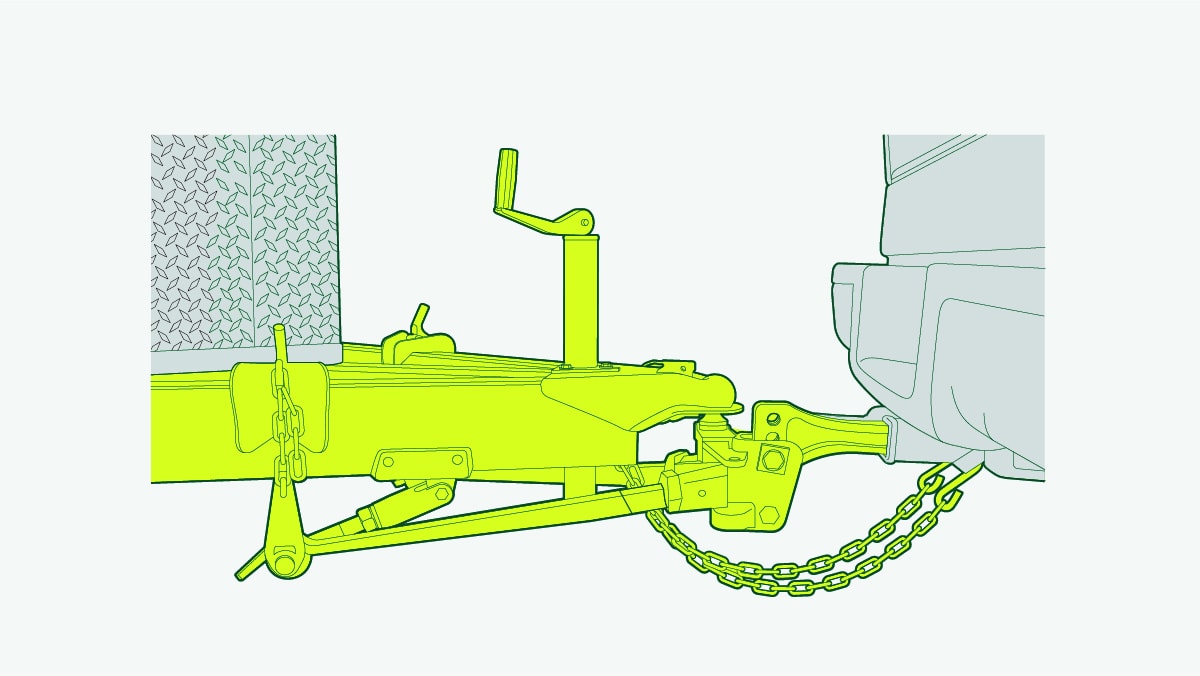
Friction Sway Control Bars
Friction sway control bars can be added to any hitch, and use friction to prevent the towed vehicle from swaying and bring it back into alignment. They come in a right-hand or left-hand application and one or both can be used for additional sway protection. Friction sway control bars are cost-effective but interfere with the trailer’s ability to turn, so they need to be removed when backing up or driving in slick conditions. This type of sway control is most useful for smaller towing situations as opposed to longer trailers.
Average Cost: $50 to $75
Electronic Tow Control
If you do start to sway when towing your travel trailer, it’s useful to have a device that electronically monitors forces on your trailer. When sway is detected, it pulses your trailer brakes automatically to keep the trailer tracking straight. This can be used in addition to other weight distribution and sway control systems.
Average Cost: $400 to $500
What If I Start to Sway?
Even with the best sway bars, stabilizers, and careful packing, you’re bound to encounter sway. Don’t panic.
- Slow and steady steering will help straighten your trailer and tow vehicle.
- Don’t attempt to counter-steer, as this can cause the sway to get worse and make you lose control.
- Don’t brake the towing vehicle. Instead, brake the towed RV very slowly, using your auxiliary brake’s manual override.
- You can use an electronic tow control monitor which automatically brakes the towed vehicle with the proper amount to stop sway.
By choosing the right weight distribution or sway bar system for your trailer—and taking steps to prevent sway before you leave home—you’ll be on track for a great trip.
This article has links to products that were carefully selected by our editors. We may earn commission on your purchases from these links. Visit this page for the full details of our affiliate marketing policy.
Meet the Author

Rob Cochran
Rob Cochran is the Head of RV Service at Togo RV. With over 30 years in the RV service industry, he’s passionate about making life better for RV owners and technicians. He’s an RV Industry Association Master Certified RV Technician and the Education Chairman for the Florida RV Trade Association. In addition to working in the industry, Rob has been RVing since 1993, which is when he purchased his first camper.
Get the most inspiring stories from the road sent directly to your inbox.

- Trip guides
- Trip Planner
- Sign up Log in Sign out
- Log in Sign out
- ROADTRIPPERS MEMBERSHIP
- RV RESOURCES
Plan your journey, find amazing places, and take fascinating detours with our app.
We couldn't find an existing Roadtrippers account using that service. Please try signing in with another option or create a new account with Roadpass.
We need your email address to send you trip itineraries and other updates.

How To Stop Travel Trailer Sway
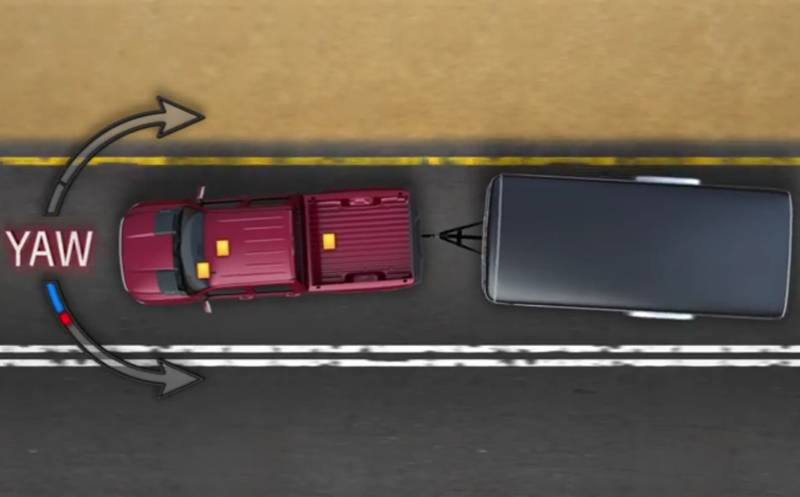
Sharing is caring!
Thanks for your support! If you make a purchase using our links in this article, we may make a commission. And, as an Amazon Associate, I earn from qualifying purchases. See the full disclosure here .
Towing a travel trailer can be tricky, and even dangerous if you don’t know how to stop travel trailer sway. If you’ve ever seen your trailer drifting side to side or felt the force of it pulling you all over the road, you’ve experienced sway.
Trailer sway, or fishtailing as it’s often called, can be a true white-knuckle experience. If you’re in love with your travel trailer, but not with the thought of towing it down the road, we’re here to help!
In this article, we will share with you a few simple things you can do to minimize travel trailer sway. We will also prepare you for how you can stay calm, and recover if fishtailing occurs.
We will cover everything you need to know to proceed with confidence and stay safe on your next travel trailer adventure!
6 Reasons Why Does a Trailer Sway?
If you want to stop travel trailer sway, you must first understand why sway occurs. There are six main causes of sway.

One of the most common causes of travel trailer sway is the wind. Travel trailers sway because they are top-heavy. Also, with their large, flat sidewalls, a small gust of wind can push them to one side or another.
2. Passing High Profile Vehicles

Any time your travel trailer passes by a large vehicle, such as a semi-truck, a vacuum is created between your RV and the semi-trailer. Once one of you passes the other, the low pressure is broken, pushing you away from each other. Being prepared for this attraction/detraction effect can minimize travel trailer sway.
3. Improper Distribution of Weight
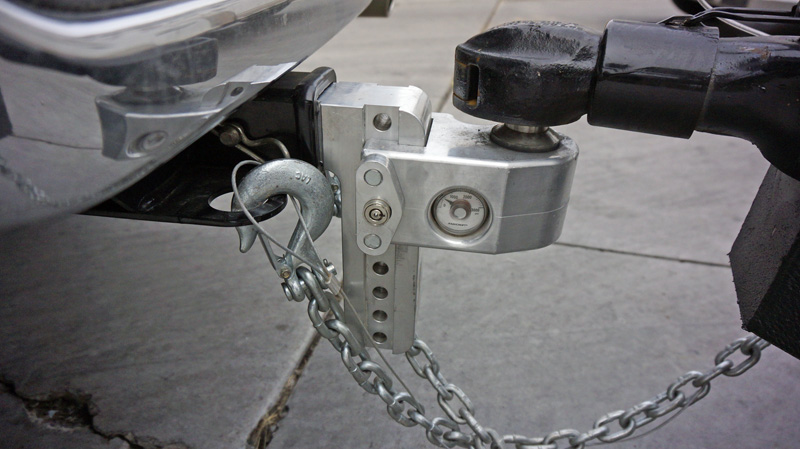
Improper weight distribution, particularly if there is not enough weight near the hitch, will cause increased sway. According to Purdue University , the optimal tongue weight of a travel trailer is 10-15% of the RV’s Gross Vehicle Weight (GVW). Fifth wheels should have a hitch weight of 20%.
4. Overloading Your Trailer or Your Tow Vehicle
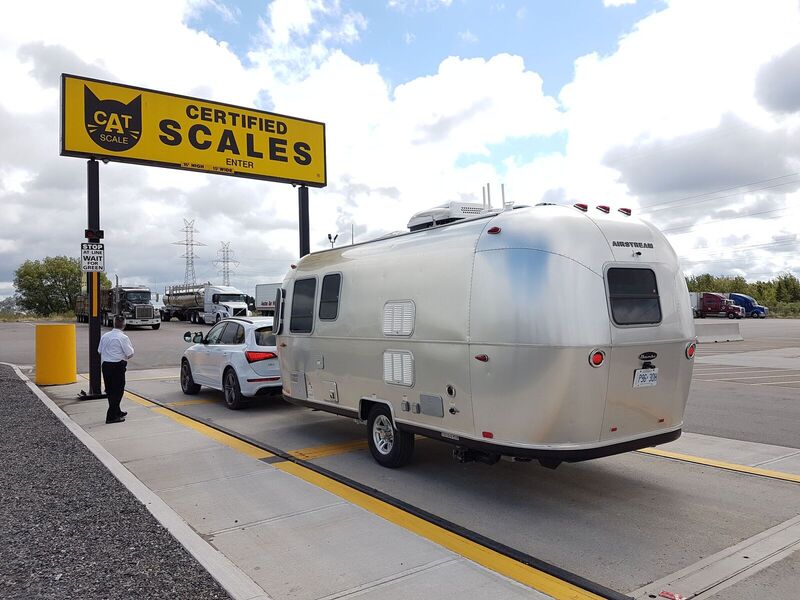
Every tow vehicle has a Gross Vehicle Weight Rating (GVWR). If your RV has a total weight over that manufacturer-approved amount, you risk fishtailing. It is important to consider the weight of all cargo, including passengers, in your calculations. If something unfortunate happens, insurance companies deny claims due to exceeding the GVWR.
5. Improper Tire Pressure
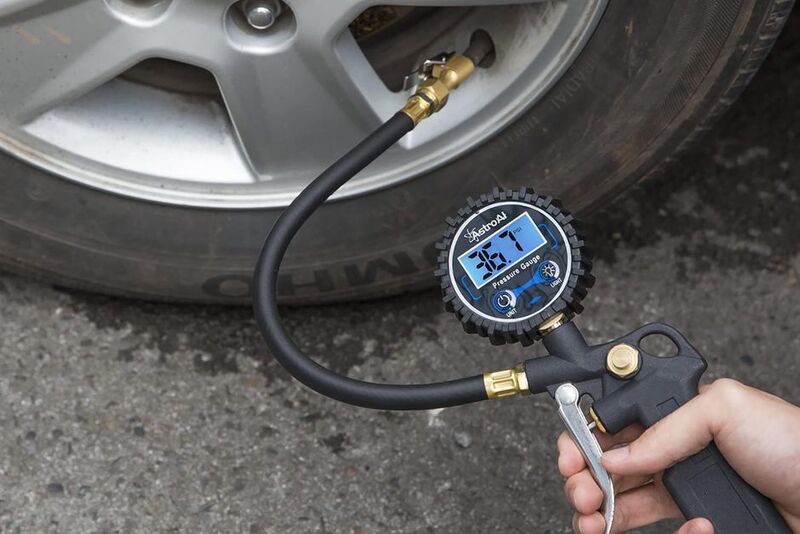
Underinflated tires can reduce the load capacity of your tow vehicle. Remember, overloaded vehicles are prone to sway.
6. Uneven Roads or Potholes

Uneven roads, potholes, dirt roads, and other road hazards can also cause sway. If there is no alternative, you should cross these sections of the road at a slower speed for better control.
The Right Towing Set Up to Minimize Travel Trailer Sway
Now that we have established what might cause an RV to fishtail, we can focus on building the right towing set up to minimize travel trailer sway.
1. A Vehicle With a Tow Package
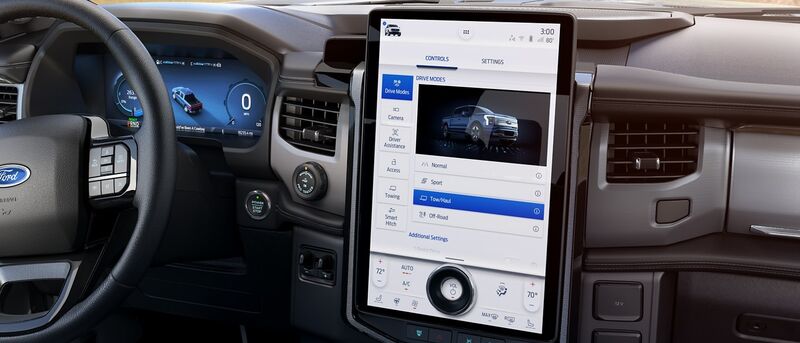
The vehicle that you use to tow your travel trailer can have a huge impact on how much sway you experience. A vehicle with a long wheelbase will be less susceptible to sway.
You should also choose a car, truck, or SUV equipped with a tow package. A tow package ensures your vehicle has all of the installed components needed to “grip it and rip it” down the road.
2. Weight-Distribution Hitch
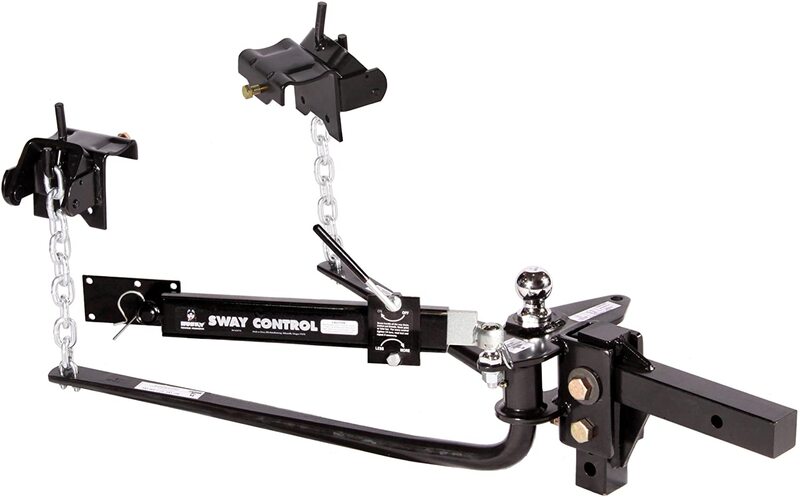
When you pair the best towing hitch with your properly equipped vehicle, you have the greatest chance of minimizing travel trailer sway. Weight-distribution hitches spread across all of the axles, so it’s not focused completely on the ball hitch.
Proper weight distribution will help prevent sway from starting. Weight distribution hitches also help prevent the back of the tow vehicle from dipping. This ensures the driver has more control to overcome sway should it occur. Additionally, weight distribution hitches with spring bars apply some side-to-side counterpressure that can help reduce sway.
3. Sway Control Device
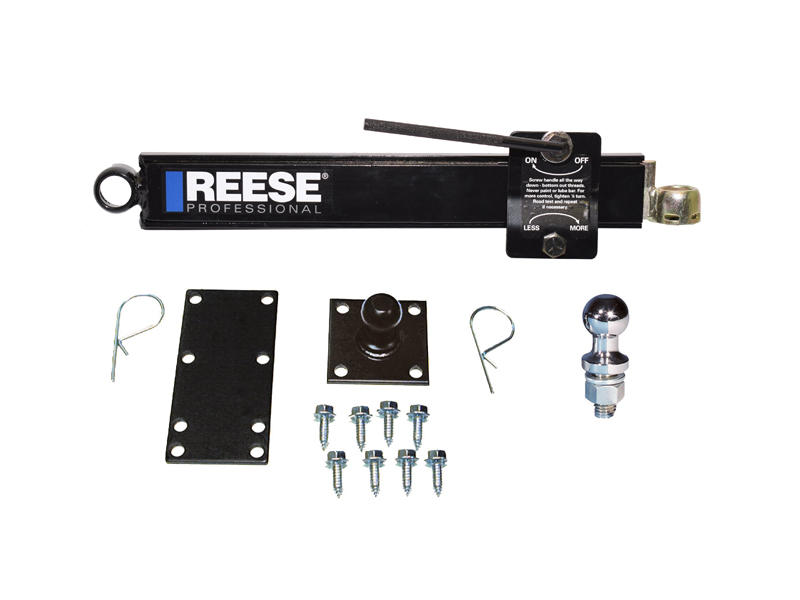
Even more important than a weight-distribution hitch is a sway control device. This crucial piece of equipment creates resistance against side-to-side movement. Its sole purpose is to reduce sway.
If you have a smaller trailer, a sway bar may be all you need to reduce travel trailer sway. But more commonly, you will want to use a sway control device in addition to a weight-distribution hitch. Many weight distribution hitches come equipped with sway control devices. Even if your weight distribution hitch doesn’t include a sway control device, it is usually very easy to add one.
What Causes Trailer Sway?
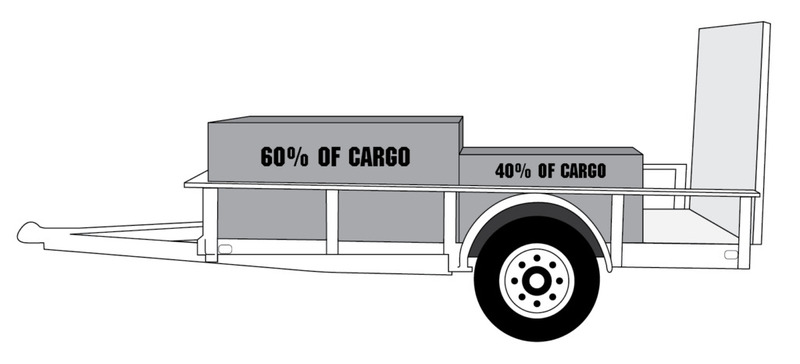
Travel trailer sway is sometimes unavoidable, but more often sway is caused by human error. Fortunately, there are many new habits you can employ that will help prevent sway.
It is very important not to overload your trailer or your tow vehicle. Always check the specifications of both your tow vehicle and RV (the Gross Combined Weight Rating or GCWR) and stay well within the guidelines. Keep the tires of your travel trailer and tow vehicle properly inflated to avoid accidentally reducing the load capacity.
U-Haul suggests loading 60% of your cargo in the front half of the trailer to avoid sway. The same can be applied to packing gear for a camping trip. Don’t forget to secure it so it doesn’t shift as you travel down the road.
If you properly pack your camper, you will reduce the likelihood that the backend of your camper will start to fishtail. Proper weight distribution also puts more weight near the tongue, thereby giving you better control of the RV.
A cardinal rule while towing a travel trailer is to avoid sudden movements whenever possible. Remember that every small movement of the steering wheel is amplified when towing a trailer.
You should familiarize yourself with your route before you travel. If you know what lane you need to be in well before an exit, you can avoid sudden lane changes.
It is also a best practice to anticipate travel conditions and plan accordingly. If possible, avoid traveling on exceptionally windy days. Finding alternative routes that go around construction zones can prevent many potential travel trailer sway battles.
Use RV-friendly trip planners like RV Life Trip Wizard that help you avoid construction zones and other roads that are not suited for your motorhome or travel trailer.
What Is Trailer Sway and Why Is It Dangerous?

Trailer sways side-to-side, it can be dangerous to you and other vehicles on the road. If not properly corrected, the side-to-side movement of the travel trailer can build momentum. If not corrected, the tow vehicle’s tires can lose their grip on the road as the car, truck or SUV starts rocking.
This can cause the trailer to drift into neighboring lanes, jackknife into the tow vehicle, or even flip itself and the towing car. The bottom line is that travel trailer sway puts everyone on the road in great danger.
4 Steps To Recover From Trailer Sway
Even the most prepared drivers will not always be able to prevent sway, so you need to know how to recover from trailer sway.
If you grew up in the midwest as I did, you have likely heard the term “don’t veer for deer.” This popular euphemism warns against overcorrecting. We can apply this same warning to trailer towing. If you feel your trailer start to sway DO NOT react impulsively and steer the wheel rapidly in the opposite direction.
1. Keep the Wheel Straight

If you try to steer out of the sway, your sudden movement will only increase the problem. You will almost certainly cause your travel trailer to fishtail more. Instead, hold the steering wheel firmly and keep it straight.
2. Gentle Brakes
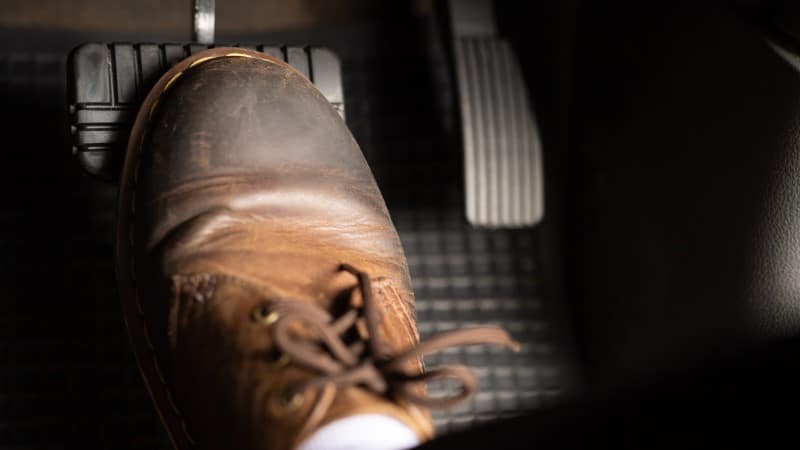
Your next priority should be to slow down. But do this carefully. Resist the urge to slam on the brakes since this will intensify the problem. Instead, you should let up on the gas pedal and allow your vehicle to slow on its own. Once you have started to slow, you can gently apply the trailer and tow vehicle brakes.
3. Pull Over and Inspect the Aftermath
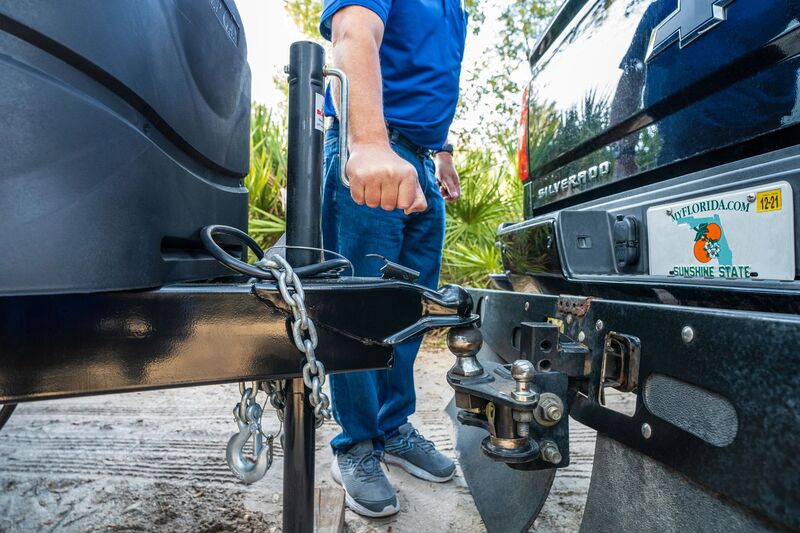
As soon as you regain control, pull off the road and evaluate your weight distribution. Make sure your cargo has not slid around. Also, make sure that your hitch and sway bar are both properly connected.
4. RVs Cruise, Racecars Race
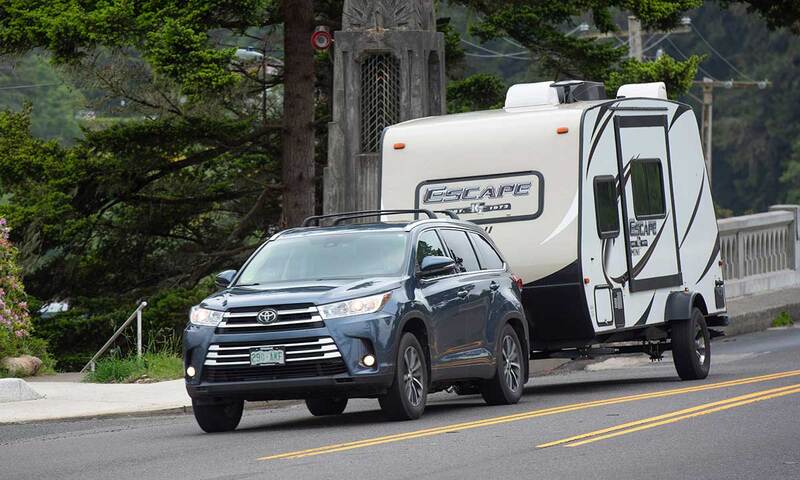
When you venture back onto the road after experiencing sway, you will probably be a little timid. That’s for good reason as sway can be both dangerous and scary. You will want to reduce your speed to avoid sway going forward.
RVers sometimes forget that the tow vehicles are made for torque, not speed. Cruise down the road at a manageable pace. A good rule of thumb is to continue at a speed 10 mph slower than the speed you were traveling when you first felt sway.
Controlling Sway on Your RV is Possible
You can control sway on your RV when you are aware of the many causes. Wind, high profile vehicles, improper weight distribution, overloading your trailer, improper tire pressure, poor road conditions, and human error can all contribute to travel trailer sway.
You can minimize the likelihood of sway by investing in and maintaining quality equipment, packing carefully, and pre-planning your route.
Even with the best equipment and preplanning, there will always be factors out of your control. The most experienced and aware drivers can be caught off guard. How you attempt to recover when your trailer begins to fishtail can make all the difference.
Do not slam on your vehicle brakes. Instead, allow the vehicle to slow on its own. While slowing, be sure to firmly grip the steering wheel keeping it straight. Once you begin to slow, gradually apply your trailer brake if you have one. Never try to steer out of the sway.
Keeping your composure, and reacting appropriately will ultimately help you recover from sway should it occur. Doing all of the above will build your confidence and keep you safe on the road.
Related Reading:
Most common travel trailer ball hitch size, which rv is the easiest to drive, 35 biggest rv beginner mistakes to avoid, 20 best ways to reduce rv weight, when is it too windy to drive an rv, about the author, laura tyrell – author and part time rver.
Laura is a part-time RVer and a full-time mom of three. Long-time campers and RVers before children, Laura, and her husband have fallen even more in love with the RV lifestyle since becoming parents to a child with food allergies.
Having her own kitchen on wheels makes her RV trips amazing. Laura is passionate about finding ways to make traveling with young children fun, easy, and attainable.

1 thought on “How To Stop Travel Trailer Sway”
It makes sense that you should avoid overloading your trailer. I need to get a trailer that I can use to load some equipment. I’ll be sure to avoid loading too much.
Leave a Comment Cancel reply
Save my name, email, and website in this browser for the next time I comment.

RV Zone is reader-supported. When you buy through links on our site, we may earn an affiliate commission. Learn more
The Best Travel Trailer Hitches for Your Camper Vehicles

Writen by Tom Hank

Fact checked by Joseph Varney
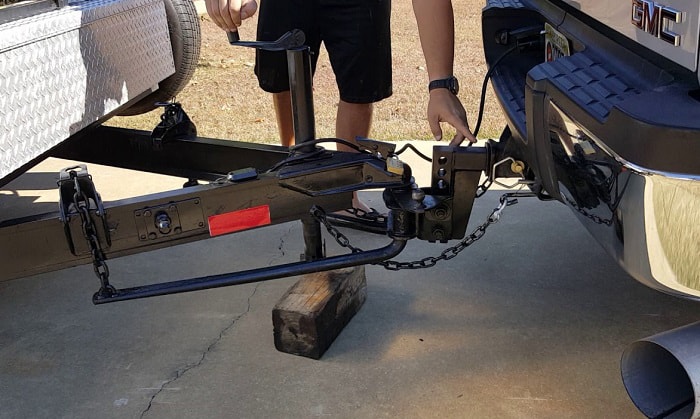
A receiver hitch for travel trailer helps provide an anchor to secure towed loads. Installing a reliable travel trailer towing hitch can help prevent many on-road vehicle-pulling accidents. But what is the best travel trailer hitch on the market?
Buyers should know that no ‘end-all’ model is classified as the one-and-only best tow hitch. Instead, it is important to take a look and think about the different factors associated with searching for an ideal travel trailer hitch system for specific demands.
Some of the things to consider are:
- Unloaded Vehicle Weight: The weight of the towing vehicle from its manufacturing. This reading does not include the weight of any add-ons after the vehicle’s initial purchase development.
- Trailer Towing Capacity: The maximum towing limit of the pulling trailer’s tongue. The pulled load should not exceed the maximum trailer tongue weight. Otherwise, the hitch may fail and release the towed vehicle, even while on the road.
- Towing components: A standard hitch setup for a travel trailer generally uses the following parts: ball mount, trailer ball, safety cables (or chains), a pin, and clip. A reliable RV hitch kit should come with these components. However, these items might also be available as aftermarket purchases.
Remember that the factors mentioned above are not the only elements to consider when shopping for the right travel trailer towing hitch. Keep reading to gain more insight about these elements in greater detail.
First, here is a look at different yet excellent choices for travel trailer hitches.
Table of Contents
Top 11 Travel Trailer Hitch Reviews
1. eaz lift 48059 weight distribution elite kit.
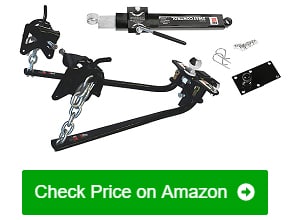
Although travel trailer hitches usually have prices that can break banks, I was content to see this particular model’s costs to be at a mid-range point. Thankfully, the manufacturer did not sacrifice the durability and strength of this model.
It has a 1,200-lb maximum tongue weight with a maximum gross trailer weight rating of 12,000 lbs. I find it surprising that this weight distribution hitch kit can achieve such a feat while maintaining a relatively compact design. That reasonably small frame also made it convenient during removal and storage.
Moreover, the high-quality engineering on the steel construction made this hitch more rugged than other options, especially when compared to the low-quality units I tried.
I would also like to mention that this steel build is a top-notch chrome-molybdenum-grade variant. It means that this kit’s construction can withstand high heat without the significant risk of breaking. It also means that it ensures passengers in the towed motorhome or trailer experience a stable and comfortable ride.
The next feature I adored is the built-in U-bolts. Coupled with the safety chains, I am relieved that this kit has the necessary hardware for a proper and safe installation.
- The mid-range price tag should fit many budget allowances
- Tongue weight capacity and Gross trailer weight rating limit are fairly high
- High-quality chrome-molybdenum-grade steel construction
- Built-in U-bolts enhances convenience and safety during and after installation
- May not be compatible with some travel trailers without modifications
2. Husky 32218 Center Line TS Hitch
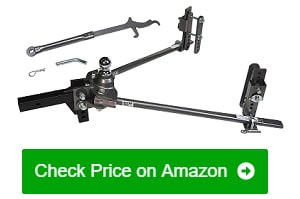
While other trailer hitches only provide secure couplings between towing and towed vehicles, this Husky Center Line TS with spring bars brings weight distribution and built-in sway control in one device.
Furthermore, just about everything I needed for the installation to work is in the kit. In turn, it did not require me to spend time going back to the store.
I also like to mention that this hitch maintained a secure connection after many trips. I tested it for about 17 days while making 26 total camping and road trips. This model performed as intended. I would even go as far as to say it provided me with flying colors for its overall performance.
Initial installation was also a breeze. It took me less than an hour to install it to a 2015 Ford Expedition. But additional testing presented me with some problems with certain towing vehicles possessing uniquely designed pulling tongues. Modifying the kit slightly solved this concern.
- Weight distribution and anti-sway control in one travel trailer hitch
- Complete hardware included in the kit
- Able to withstand strong winds
- Quiet and secure performance for short- to medium-length trips
- Only takes less than an hour to install
- May creak or squeak during long road trips
- Might not fit some towing tongues well without modifications
3. Equal-i-zer Weight Distribution Kit
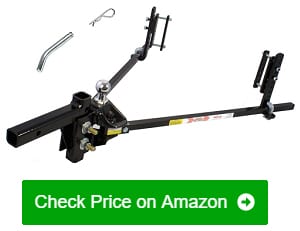
I can safely say that this Equal-i-zer hitch is one of the top-rated weight distribution hitches I have tried. It presented my camper with many benefits, such as the lack of the need to disconnect or disassemble the hitch assembly when backing up my vehicle.
Moreover, this model is also an anti-sway hitch for camper vehicles. It uses a 4-point stabilizing system to help reduce friction and sway during tows. This model also has linear friction at two points, allowing it to provide similar stability as compared to using an add-on 8-point sway control accessory.
Its stability was also on point, seeing that the friction sway control feature also provided a proper weight distribution across my vehicle’s towing tongue. The result is a more convenient and safe ride, including improved steering and braking.
One shortcoming I noticed is that this kit is not the quietest setup in my books. This hitch setup for travel trailer makes a creaking sound while towing a trailer. Additionally, it is not advisable to lubricate the contact area. Doing so will reduce the anti-sway function, increasing on-road risks of accidents.
- No need to disconnect or disassemble the kit while reversing the vehicle
- A 4-point sway weight distribution hitch that removes most side-to-side motions
- Excellent weight distribution to the towing vehicle’s tongue
- Top-notch compatibility for it can fit many vehicles, including utility trailers
- The immutable creaking sound might be an issue for some users
4. Fastway e2 Weight Distribution Kit
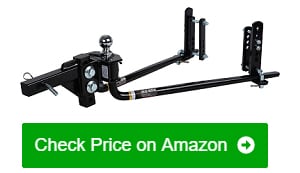
Although the price of this model falls within the average cost of many trailer hitch receivers, it has features that I found to provide me with more value than its overhead. For instance, the traditional spring arms provided my towing setup with an optimal distribution of the weight of both the towing and towed vehicle.
Take note that this setup uses a round bar and a trunnion. The latter component provides towing vehicle users like me with better ground clearance than many other choices on the market.
I also approve that the manufacturer decided to develop a hitch design that does not require disassembly while backing up my vehicle. However, I should mention that this setup that does not require a disconnection should be on a flat surface. Otherwise, attempting it on a steep uphill will still require me to take the system apart.
The install process is also unique as compared to other similar products. I can set this kit up as a front-mounted hitch or connect it to my vehicle’s rear axle. This design also supplies vehicle-pulling options for many users.
Also, this unit has a cohesive anti-sway system. This feature uses friction within the brackets and spring arms to reduce trailer sway from the trailer during tows. It does fairly well in removing unwanted side-to-side motions. But I wish that it does better in eliminating up-and-down movements as well.
- Traditional spring arm design offers optimal weight delivery
- Excellent ground clearance, thanks to a trunnion
- Does not require disassembly when backing up a vehicle on a flat surface
- Can be installed in either the front or back of a towing vehicle
- Anti-sway system efficiently removes side-to-side movements
- 10-year limited warranty
- Might still demand taking the kit apart if the vehicle backs up on a steep hill
5. Andersen Hitches Weight Distribution Hitch
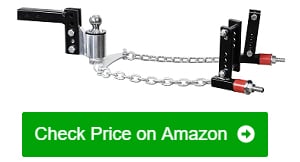
While many hitches with weight-distributing features focus on using the traditional spring bar setup, this Andersen weight distribution hitch revolutionized how these components work. The company removed the conventional spring bar design and created a relatively simpler chain system.
This chain design results in a lighter and quieter towing hitch for campers. In comparison, many other hitches generally weigh more than double what this model has to offer. Its lightweight construction also made it possible to make the install and removal setup easier than others.
Installation is also a reasonably straightforward task, thanks to the detailed instructions. But individuals that wish to purchase this kit should heed my warning: it can be easy to bend the triangle plate and ruin the urethane springs. Therefore, make sure to pay extra care when setting up these parts.
Additionally, I liked that this hitch has two ways to attach and detach from a tow vehicle. First is the use of the provided ¼-in. nut; tightening it will secure the connection, whereas loosening this component undoes the attachment. I can also use an electric trailer tongue jack to do this process faster and with less hassle than before.
- Uses a chain design to make the system lighter and quieter than others
- Straightforward installation, thanks to the detailed instruction manual
- Two options to attach and detach the tow vehicle through this hitch
- Self-lubricating system that does not require extra grease or lubricant
- Requires care not to break some parts during installation
6. CURT 17500 TruTrack Weight Distributing Kit
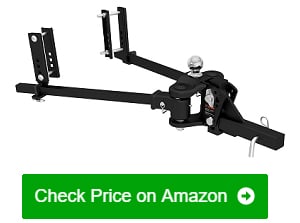
I find this CURT adjustable RV trailer hitch to be one of the more expensive units on the market. But the bump in its price tag is justifiable because it offers a myriad of functional features. One example is its weight rating.
With a 10,000-lb. maximum tow weight rating, along with a 1,000-lb maximum tongue weight rating, this vehicle’s towing capacity exceeds most of its competitors. However, its compatibility limits this tow vehicle weight rating because this unit only fits 2×2-in. trailer hitch receivers.
Moving forward, another feature that I liked about this weight-distributing hitch kit is its five adjustable locations. With it, I can tow multiple vehicles, provided that the maximum trailer weight of all pulled objects does not exceed the system’s allowable load.
I should also mention that distributing the weight is customizable on this kit. This adjustable hitch has a movable shank. Coupled with spring bars that move 30 to 70 degrees, this model can fit many tow vehicle tongues, as long as they have 2×2-inch receivers.
- Maximum tongue weight rating and tow weight rating exceeds many competitors
- Five adjustable locations for towing multiple vehicles
- Adjustable shank to enhance compatibility and flexibility
- Carbide black powder coating provides weather resistance to the system
- Might not be compatible with hitch receivers that are not 2×2-in. in size
7. Ultra-Fab 35-946403 Travel Trailer Hitch Receiver
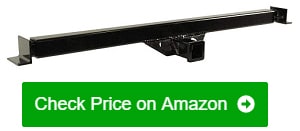
The 53-lb weight of this trailer hitch receiver triggered my skepticism. But this lightweight model is a solid performer on and off the road. Its performance can even outshine some of its heavier competitors.
Starting with the installation, it only took less than 2 hours to complete. The installation process could be faster, but I was chatting with my friend at that time. I should mention that some welding might be necessary to enhance the hitch’s stability and strength.
Furthermore, this trailer hitch is a good choice for towing fairly light objects. I tested it on pulling things like generators and bike carriers. However, anything heavier than about 3,000-lbs will compromise this hitch’s structural integrity.
Still, it can be quite difficult to complain about its shortcomings after seeing its price tag. It is one of the least expensive models on the market for a product of its class. I tried searching for even more inexpensive hitches. The outcome of my search is that I mostly found options that are lacking in quality features.
- Lightweight 53-lb. construction without sacrificing overall performance
- Installation is reasonably quick and easy to complete
- Ideal for towing sufficiently light objects, such as generators and bike racks
- Available at an inexpensive price
- Might not be good for towing anything with a weight heavier than 3,000 lbs.
- Some welding might be necessary to achieve a stable finish
8. CURT 17063 Weight Distribution Hitch
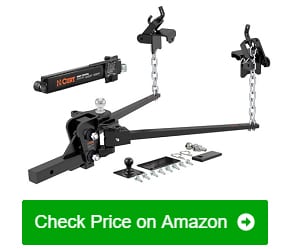
Perhaps the most likable aspects of this weight-distributing trailer hitch are its installation and removal. These procedures did not demand a significant amount of time and effort from my experience.
First, I would like to go about the install process; it starts by mounting the ball and plate onto the trailer frame. Then, I secured these parts using the included self-tapping screws. As for the sway control ball, this component came pre-installed, thus cutting the installation time by quite a bit. Finally, attach its bar to the balls and install the clips.
The removal process is also reasonably straightforward. It only required me to unclip the bar. Then, I followed the install process but in reverse. When I found myself getting stuck with the setup, I can consult the detailed instruction manual for help.
This kit also includes a snap-up lever, which provided my tow vehicle with extra leverage. This feature, it adds extra security for the setup’s assembly.
I should also mention that if I had the hitch head at the highest setting, the maximum extended length is going to be 7 in. At that point, it is a reasonable height to give the tow hitch’s tongue extra ground clearance.
Moreover, I like the build quality on this trailer hitch. Its construction has a corrosion-resistant carbide black powder coating that can also protect the system from harsh weather.
- Installation and removal are reasonably quick to complete
- Snap-up lever provides the setup with extra leverage
- Hitch head offers additional clearance at the highest setting
- Superb corrosion-resistant build quality
- Customers may need to buy compatible sockets for the assembly
9. Husky 30849 Weight Distribution Hitch
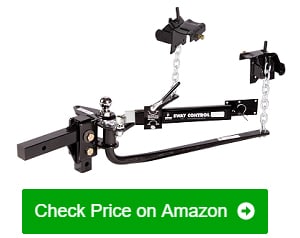
This weight distribution hitch does not only provide optimal balance and stability to tow and towed vehicles; it is also a workhorse. With a weight rating of 1,200 lbs, and a gross trailer weight of 12,000 lbs., this hitch can help pull many objects without the worry of them detaching in the middle of a road trip.
I would also like to circle back to this kit’s stability because this trait is one of this product’s highlights. Using a 2-point anti-sway mechanism, it manages to even out significant rocks or sways that might otherwise come from pulling a heavy load. The manufacturer also gives the option to buy two more sway control balls for extra stability.
After taking the items from its box, the next step was to install this hitch onto my tow vehicle. The installation was reasonably easy because it only took about three major steps to finish the process. First, I ensured that both vehicles were level. Then, I attached the ball. The final step was to secure the chains.
This kit also shines from its built-in pivoting. I managed to pivot the hitch to about eight inch vertically. That pivot range is generally more than what the typical weight distribution hitch can usually offer.
- Above-average 12,000-lb. gross trailer weight and 1,200-lb. tow weight rating
- 2-point anti-sway system for optimal stability
- Option to purchase additional sway control balls for additional stability
- Fairly easy installation
- Able to pivot with an 8-in. range
- The retainer pin might need to be sturdier
10. CURT 13703 Adjustable Trailer Hitch
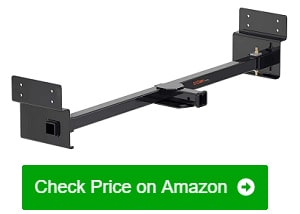
I found this adjustable trailer hitch to be quite the contender in the midrange category. It has a 3,500-lb gross trailer weight and a 350-lb tongue weight. It contends well with other similar products in its class with those measurements.
That vehicle pulling prowess resonates with the kit’s durable steel build. I found the construction to have a black powder-coated finish to help prevent the unit from corrosion and rust. This coating also aids in preventing damage to the system from the elements, especially from the sun’s UV rays.
Next, I admire this hitch’s versatility. It can accommodate trailer tongues with widths between 22 and 72 in. At that range, this product’s compatibility is reasonably excellent across the board. It can even work on different frame applications, including box, C channel, and I-beam variants.
I also found out that this particular hitch passes the Detroit engineering facility SAE J684 standards. In turn, I am at peace, knowing that this hitch system supplies me with top-rated performance and longevity.
Moving forward, the installation is also fairly easy to finish. One of my test vehicles for this product is the 2008 Jayco fifth-wheel trailer. Installing this hitch onto that RV was not a laborious ordeal.
- Competitive gross trailer and tongue weight
- Durable steel built with black powder coating is resistant to damage
- Versatile hitch that can fit different applications like a box frame
- Easy to install on many compatible vehicles
- May need to buy the hitch clip, pin and lock to complete the installation
11. PSAUTO Adjustable Trailer Hitch
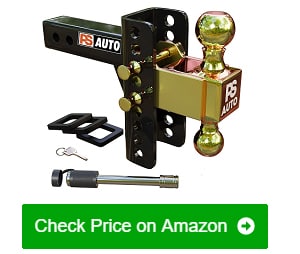
Although it seems that weight distribution hitches dominate the market heavily, I found this model with a trailer ball hitch design can compete with other similar products. I can safely say that previous statement because of this hitch’s many top-notch features, especially its 20,000-lb tow weight capacity.
With this trailer hitch, a compatible towing vehicle can pull more objects than a typical weight-distributing hitch. It even has a distinct channel-style shank, allowing the setup to appear or disappear for convenient use and storage. Also, this system’s weight limit allowed me to say that there might be no such thing as too much weight for towing.
That durable nature also comes with a weather-resistant construction. I left this hitch outdoors for a while to expose it to the elements. Its build withstood the harshness of rain, sleet, and dirt. Even dirt and road grime were not enough to damage the kit’s rugged parts.
But in case this hitch becomes damaged from natural causes, it comes with a limited lifetime warranty. The manufacturer also offers a money-back guarantee to its customers if this product proves to be defective upon purchase.
- Maximum tow weight capacity of 20,000-lbs.
- Unique channel-style shank allows convenient use and storage
- Weather-resistant construction repels damages from the elements
- Limited lifetime warranty and money-back guarantee
- Might do better in removing sways
Travel Trailer Hitches Buying Guide
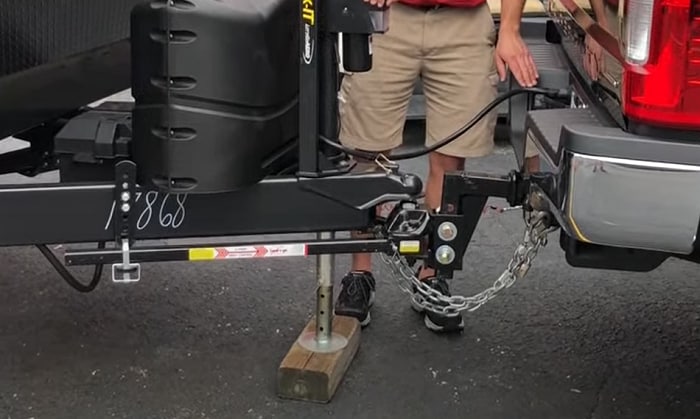
Buying a travel trailer tow hitch without taking the time to research can lead to wrong purchasing decisions. Interested buyers should start their shopping journey by looking at a trailer hitch compatibility chart.
After that initial step, think about these factors while shopping for the most favorite trailer hitch on the market:
Unloaded Vehicle Weight (UVW)
Also known as a travel trailer’s real weight, the UVW represents the weight of the RV with only the load brought by the equipment installed from manufacturing. It does not take into account additional parts like extra hitch accessories.
A tow hitch for travel trailer should support the vehicle’s UVW. Otherwise, installing a mounted hitch with a low lifting capacity can put the trailer’s tongue and the towed vehicle to crash.
Trailer’s Towing Capacity
Trailer owners can find their vehicle’s maximum towing limit by checking their owner’s manuals. If that piece of information is missing, towing vehicle owners can figure out their RVs’ pulling limit by understanding certain elements.
First, it is important to know the different weight ratings of the vehicle. If these details are absent in the owner’s guide, it might be possible to search for the information online. Make sure to use the right key phrases if you need information for specific models, like a bumper pull trailer hitch for a particular vehicle.
Also, the weight ratings required for calculating the towing capacity are:
- Gross Axle Weight Rating (GAWR)
- Gross Vehicle Weight Rating (GVWR)
- Gross Combined Weight Rating (GCWR)
- Gross Trailer Weight Ratings (GTW)
- Tongue Weight (TW)
- Curb Weight
Then, contact the trailer’s maker and give them those numbers. Aside from pulling up information about a travel trailer’s tow capacity from the weight ratings, the manufacturer may also disseminate the correct details about the vehicle’s precise pulling weight limit.
Tow Components
Ideally, the top-tier hitch for towing travel trailer comes as a complete kit. But some manufacturers also offer extra parts for reasonably inexpensive replacements.
A good tow hitch for travel trailer setup usually uses the following parts:
- Ball mount: Often comes with a hitch ball inserted into a trailer hitch receiver and secured with a pin-and-clip assembly.
- Trailer ball: Also called the hitch ball, this component is the attachment point for the trailer and the towing vehicle.
- Tow hitch pin and clip: A small metal bar or rod holding the ball mount and the tube for the hitch receiver.
- Safety cables or chains: Restrains the towed trailer from separating if the coupler or hitch fails.
Additional Features
When looking for the right hitch for travel trailer, it might be tempting to buy a unit with extra functionalities. However, make sure that these add-on items comply with safety regulations.
Some of the relatively common additional features included in some hitches are:
- Extra mirrors: Also called towing mirrors, these pieces of glass allow drivers to gain a better viewing angle than the built-in mirrors on their vehicles.
- Brake control: A feature that connects the towed vehicle’s brakes with the towing automobile’s brake system.
- Rearview camera: Helps drivers avoid obstacles while reversing their towing and towed vehicles.
Another extra feature that many towing vehicle owners often consider is a sway control bar. With it, the trailer can maintain a reasonably straight orientation despite hazards like bad weather or high winds.
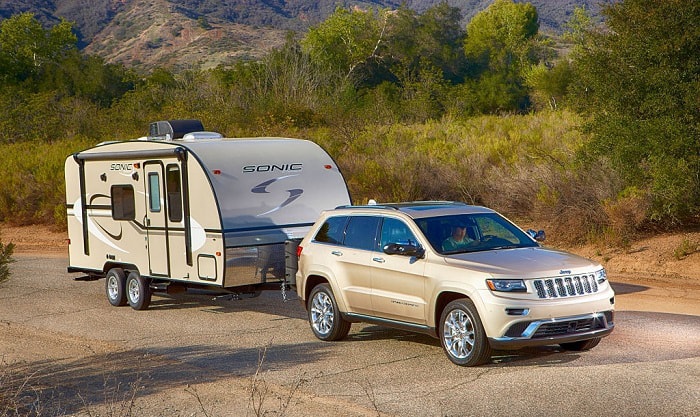
What Kind Of Trailer Hitch Do I Need For A Travel Trailer?
Camper trailer towing hitches come in different types. Understanding the distinct features and traits of the various camper trailer hitch types will help buyers purchase the correct model for their specific needs.
A camper hitch can fall under one of the following categories:
- Front mount hitch: An ideal choice for towing travel trailers at their fronts. It has a similar design to a rear-mounted design, but for the front.
- Gooseneck hitch: Mainly designed for pickups only and has an average weight capacity of 30,000 lbs.
- 5th wheel hitch: Similar to a gooseneck hitch kit, a 5th wheel hitch mounts over or at a slightly forward location of the vehicle’s rear axle. But hitches for 5th wheels can often only hold up to 24,000 lbs.
- Bumper hitch: As its name implies, this camper receiver hitch attaches directly to the vehicle’s bumper.
- Pintle hitch: It can be easy to mistake a pintle hitch with a model with a ball mount design because of their designs. But a pintle trailer hitch for camper has a hook with the same name as this hitch category.
- Weight distribution hitch: It is possible to mount a weight distribution system to either the front or rear of the vehicle. As its name dictates, this type of tow hitch distributes the trailer’s tongue weight across the towed trailer and the towing vehicle.
Buyers may use specific keywords like Hensley weight distribution hitch to look at the different models on the market. Precise key phrases can also aid in filtering search results, streamlining the online shopping experience.
Which Is Better Class 2 Or Class 3 Trailer Hitch?
Class 2 and Class 3 trailer hitches supply users with benefits often unique to each travel trailer tow hitch class. The following list is a quick look for some of the relatively common characteristics of Class 2 and Class 3 trailer hitch accessories:
Class 2 Trailer Hitch Receiver
- 350-lb. maximum tongue weight capacity
- 3,500-lb. maximum gross travel trailer weight capacity
- Ideal for hauling a bike rack or a small boat
- Fairly inexpensive
Class 3 Trailer Hitch Receiver
- 800-lb. maximum tongue weight capacity
- 8,000-lb. maximum gross weight rating
- Ideal for pulling medium boats and campers
- Reasonably more expensive than Class 2s
What Is The Strongest Drop Hitch?
A steel drop hitch for travel trailer will generally outperform other hitch accessories, such as those made from aluminum, when talking about durability and maximum weight capacity. With steel, it can provide a sufficiently long serviceable life for its users, thanks to its rigidity.
This sturdiness generally also comes with optimal support. Steel weight distribution hitches work well in flat and uneven terrain, reducing unwanted movements from the trailer’s tongue.
Does Weight Distribution Hitch Help With Sway?
Some weight distribution hitches have sway controls to help reduce side-to-side motions. Certain models may also perform better than others by supplying towing and towed vehicles with up-and-down motion reduction features. In the case your hitch trailer happens to shake and cause an annoying rattle. I recommend owning an anti rattle hitch device. Click here to lean more an article about them.
How Do I Know If My Hitch Is Class 1 Or 2?
Aside from consulting the product’s owner’s manual or asking the manufacturer, figuring out if a towing hitch for a travel trailer is Class 1 or Class 2 is possible by understanding the distinct features of each class.
Here is a quick look at the fairly common traits in Class 1 and Class 2 travel trailer hitches:
Class 1 Travel Trailer Hitch
- Often designed for domestic and foreign passenger cars
- Typically has a gross vehicle weight rating of 2,000 lbs.
- It is generally a small trailer hitch made for towing light-duty trailers
Class 2 Travel Trailer Hitch
- Often designed for passenger vehicles and light-duty trucks
- Generally has a tongue weight capacity of 350 lbs.
- Usually built for towing a boat or camper and mounting a cargo carrier.
Using the best travel trailer hitch presents users with different benefits. Some of these advantages may include (but are not limited to) enhanced durability, stability, and long serviceable life.
It is possible to get the most out of a hitch if buyers choose my suggestion, which is the CURT 17063 Weight Distribution Hitch. This model is easy to install and remove, provides great clearance, leverage and has a top-rated corrosion-resistant construction.

Hi, I am Joseph. Carpe diem! Seize the day! That’s always been my life motto. If you haven’t seen some of the most beautiful places in the country, you are missing out on incredible adventures.
The Best Protection for Your Journey
Whether you are passing a semi-truck, experiencing gusty wind, or making a quick maneuver, the Equal-i-zer hitch works to keep your trailer and family safe. Our Integrated 4-Point Sway Control™ resists more sway than any other hitch, providing safer, more comfortable towing, and our excellent weight distribution provides better steering, braking and vehicle control.

Superior Sway Control and Weight Distribution You Can Trust
4 Point Sway Control
With the Equal-i-zer’s Integrated 4 Point Sway Control™ you can relax knowing the most advanced sway control technology is working to keep you safe and comfortable on your journey.
Weight Distribution
Our patented design transfers trailer tongue weight to all axles, providing excellent weight distribution, improving steering and braking control, and providing a smooth, level, enjoyable ride.
Trailer Compatibility
The Equal-i-zer hitch works with almost any RV, horse, cargo, boat, and utility trailer, including trailers with surge brakes, giving you confidence it can be installed on your trailer.
Ease of Use
The Equal-i-zer hitch is simple and easy to use. Hitching and unhitching are conveniently done from any angle, and adjustments are simple, allowing you to hook up with ease, and spend more time making memories with the people you love.
Quality Construction
The Equal-i-zer is 100% American made from the highest-quality, American steel. We’re so confident in the Equal-i-zer hitch’s quality, we offer a lifetime warranty, so you can be confident it will provide excellent performance for as long as you own your trailer.
Where to Buy
Our dealers are specially trained on the Equal-i-zer hitch. They know which Equal-i-zer model is best for your truck and trailer, can assist you with installation, and teach you how easy it is to use with your trailer.

More Products
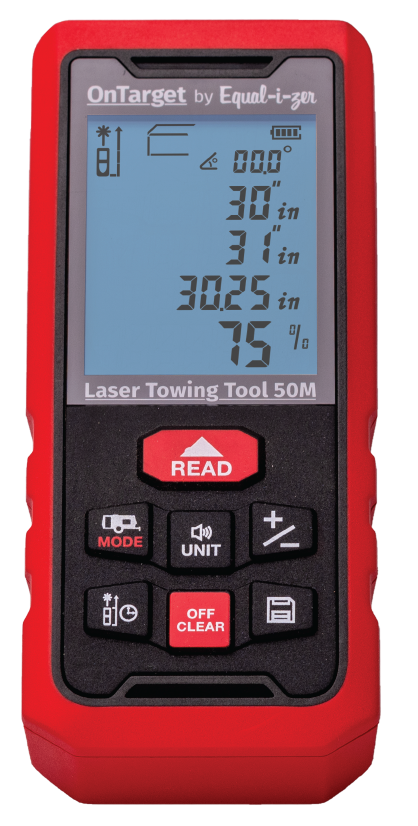
Towing Tools
Making setting up and towing with your Equal‑i‑zer hitch even easier with our innovative towing tools.
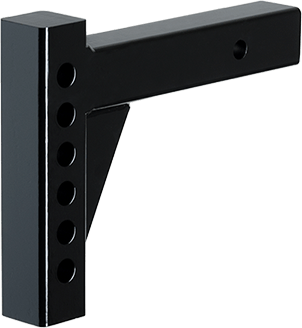
Adjustable shanks make it easy to purchase a shank that ensures optimal weight distribution setup. To determine which shank size works best for your setup, visit Find Your Shank Size.
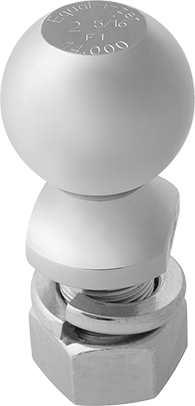
Hitch Balls
Equal-i-zer hitch balls are strong, durable, and specially made to fit Equal-i-zer hitches. Designed and engineered in the USA from the highest-quality steel, our hitch balls provide easy installation and superior strength.
Didn't find what you need?
Give us a call at 800-478-5578 or email [email protected]


- Types Of RVs
- Tow Vehicles
- Maintenance & Repairs
- RV Power & Electrical Supplies
- RV Appliances
- Living In An RV
- Travel & Destinations
- RV Gear Buyer’s Guides
![8 Best Stabilizer Hitches for Travel Trailers in [currentyear]: Find the Perfect Weight Distribution Hitch 1 Best Weight Distribution Hitch](https://www.rvingknowhow.com/wp-content/uploads/2020/06/Best-Weight-Distribution-Hitch.jpg)
8 Best Stabilizer Hitches for Travel Trailers in 2024: Find the Perfect Weight Distribution Hitch
- Last Updated: March 19, 2024
- 40 minutes read
As someone who has rigorously tested numerous stabilizing solutions for travel trailers, I understand the importance of having a reliable weight distribution hitch to ensure safety and comfort on the road.
The right hitch can significantly alleviate the swaying and instability that often plagues trailers, making your journey smoother and worry-free.
Among the variety of options I’ve evaluated, focusing on anti sway hitch and spring bar technology specifically designed for travel trailers, one product stood out distinctly.
After testing 8 top contenders in the market, the Blue Ox BXW1000 SWAYPRO Weight Distributing Hitch earned its place as my best overall recommendation.
This hitch excels in providing superior sway control and weight distribution, ensuring your trailer remains steady in various driving conditions.
Based on my experience, the top stabilizer hitches for travel trailers are:
- Blue Ox BXW1000 SWAYPRO Weight Distributing Hitch : Best overall for its exceptional sway control and weight distribution.
- EAZ LIFT 48053 Elite Bent Bar Weight Distributing Hitch : Great for its bent bar design that enhances stability.
- Husky 32218 Center Line TS with Spring Bars : Excellent for integrating weight distribution and sway control in a robust design.
- Reese Pro 49903 Weight Distributing Hitch : Ideal for its versatility and ease of use.
- CURT 17063 MV Weight Distribution Hitch with Sway Control : Top choice for those seeking a durable and reliable option with integrated sway control.
- Camco Eaz-Lift ReCurve R6 Weight Distributing Hitch Kit with Sway Control : Perfect for those who prioritize easy setup and effective sway control.
- Andersen Hitches 3350 No Sway Weight Distribution Hitch : Best for its no-sway technology and lightweight design.
- Fastway 10K RB Fastway e2 2-point Sway Control Distribution Hitch : Good for its straightforward installation and efficient sway control mechanism.
8 Best RV Weight Distribution Hitches for Safe and Stable Towing
1. best overall: blue ox bxw1000 swaypro weight distributing hitch.
![8 Best Stabilizer Hitches for Travel Trailers in [currentyear]: Find the Perfect Weight Distribution Hitch 2 Blue Ox BXW1000 SWAYPRO Weight Distributing Hitch 1000lb Tongue Weight for Standard Coupler with Clamp-On Latches](https://www.rvingknowhow.com/wp-content/uploads/2024/02/31Mj36HuqiL._SL500_.webp)
The Blue Ox BXW1000 SWAYPRO is our pick for the best overall weight distribution hitch because it comes with a pre-adjusted hitch head that doesn’t require any further fine-tuning once it’s installed.
That’s not always the case with these hitches and it makes this a great choice if you don’t have a ton of experience using them.
This trunnion-style hitch has excellent sway control which allows you to tow at faster speeds without worrying about your trailer fishtailing behind you.
Trunnions on either side of the hitch head work together with the hitch’s spring bars to create a caster effect. This effect continuously pushes inward to keep everything in line.
You’ll also be able to navigate easier when you arrive at a new campground. Some locations have tight turns and others require you to back up to get into your site.
With this hitch, you won’t have to disconnect in order to back up. But when you do want to disconnect, it’s super easy to do so.
It takes just minutes to connect and disconnect to this hitch, which gives you the freedom to drop your trailer or vehicle without any added headaches.
If the tongue of your trailer already boasts a coupler welded to the top of the frame and it doesn’t have any cross-members on the tongue, you’ll be able to utilize this hitch out-of-the-box.
It is compatible with other trailer tongues, however. You just may need to purchase additional bolt-on latches or an optional hitch head to ensure safe towing.
The Blue Ox BXW1000 has a maximum tongue weight rating of 1,000 pounds and a maximum gross weight rating of 10,000 pounds.
It also boasts spring steel construction that adds durability and strength to the entire unit and you won’t have to disconnect this hitch when you need to back your trailer up.
Things We Like
- Sway Control: Keeps everything in line so you avoid fishtailing.
- Pre-Adjusted Hitch Head: Requires no additional fine-tuning after installation.
- Easy Connection: The spring bars on this hitch are self-locking.
- Clamp-On Latches: Don’t require the use of any additional hardware for installation.
Things We Don’t Like
- Compatibility: Works best with trailer tongues with coupler welded to the top of the frame and without cross-members on the tongue.
- Price: You’ll pay a little extra for the quality of this hitch.
2. Best Budget-Friendly: EAZ LIFT 48053 Elite Bent Bar Weight Distributing Hitch
![8 Best Stabilizer Hitches for Travel Trailers in [currentyear]: Find the Perfect Weight Distribution Hitch 3 EAZ LIFT Camco Eaz-Lift Elite 1,000lb Weight Distribution Hitch with Height Adjustable Forged Shank (48053)](https://www.rvingknowhow.com/wp-content/uploads/2024/02/41nnAFIsw8L._SL500_.webp)
The EAZ LIFT 48053 weight distribution hitch is the most budget-friendly round bar hitch we could find on the market today.
The good news is that you won’t have to severely sacrifice quality to get a hitch that fits your budget.
EAZ LIFT is actually made by Camco, which is one of the more reliable brands in the industry.
It comes with an adjustable ball mount but does not include the hitch ball itself. So you’ll have to grab this accessory separately to make this hitch work for you.
The bars on this hitch, however, are actually interchangeable. This is uncommon amongst this type of hitch but it serves to provide a smoother ride.
The bars use positive latching action to attach to your trailer tongue and the round spring bars on this hitch are machine tapered and forged longer for added strength and durability.
These spring bars can actually be removed if you chose to operate it as a more standard weight distributing hitch. Doing so, however, significantly reduces the hitch’s tongue weight and gross weight ratings.
The hitch is adjustable to fit many different trailer-vehicle combinations and it comes with clips and bolt package for easy installation.
The shank size is 2” x 2” with a 10-inch length, a 2.5-inch drop, and a 5.5-inch rise.
The entire package is also backed by the manufacturer’s 5-year warranty, which is always a good sign when it comes to your safety and the safety of your vehicle/trailer investments.
The EAZ LIFT 48053 also has a maximum tongue weight of 1,000 pounds and a maximum gross weight rating of 10,000 pounds. If you remove the spring bars, however, those ratings drop down to 600 pounds and 6,000 pounds, respectively.
- Price: It’s the most budget-friendly hitch on our list.
- Versatility: Spring bars can be removed to use it as a more standard hitch.
- 5-Year Manufacturer’s Warranty: Camco stands behind the quality of their product.
- Adjustable Hitch: Can adapt to fit a variety of trailer-vehicle combinations.
- Hitch Ball Not Included: You’ll have to purchase a compatible hitch ball separately.
3. Best For Quiet Use: Husky 32218 Center Line TS with Spring Bars
![8 Best Stabilizer Hitches for Travel Trailers in [currentyear]: Find the Perfect Weight Distribution Hitch 4 Center Line TS Weight Distribution Hitch - 2-5/16" Ball - 12,000lbs](https://www.rvingknowhow.com/wp-content/uploads/2024/02/3164m3UjsvL._SL500_.webp)
If you’re looking for a trunnion-style hitch that doesn’t cause a bunch of extra noise while you’re driving down the highway, check out the Husky 32218 Center Line TS.
Annoying noise can be an issue with other sway bars and weight distribution products, but that’s not the case with this hitch.
One of the reasons for this noise reduction is the fact that this hitch doesn’t use chains to attach to the tongue of your trailer.
Those chains jangling around are primarily what causes the noise in other models. But you’ll be able to hear (and feel) the difference when you drive with this hitch.
The unit combines sway control and weight distribution to provide quiet performance without the need for any additional hardware. This makes it super easy to install.
The handles on the bars further aid in securing them to (and removing them from) your trailer and the frame brackets are easily adjustable to mount on a variety of trailer tongues.
The Husky 32218 Center Line TS has a maximum tongue weight rating of 1,200 pounds and a maximum gross weight rating of 12,000 pounds.
The hitch itself weighs a total of 116 pounds, which is lighter than many. This lighter weight makes it easier to install and remove as needed.
- Quiet Operation: No noisy chains like other hitches.
- Built-in Sway Control: Doesn’t require installation of any additional hardware or accessories.
- Lightweight: This is a relatively lightweight hitch compared to similar models.
- Easy Installation: Handles on the frame brackets make it easier to install.
- Compatibility: This hitch is built for a 2 and 5/16” hitch ball.
4. Best With Preinstalled Hitch Ball: Reese Pro 49903 Weight Distributing Hitch
![8 Best Stabilizer Hitches for Travel Trailers in [currentyear]: Find the Perfect Weight Distribution Hitch 5 Reese Pro 49903 Round Bar Weight Distribution Kit with Sway Control](https://www.rvingknowhow.com/wp-content/uploads/2024/02/31u9q1VtAML._SL500_.webp)
The Reese 49913 Wd Rb Pro round bar hitch is a great option if you’re looking for a weight distribution hitch with a preinstalled hitch ball.
This means you won’t have to worry about finding a hitch ball separately and risk picking one that’s not compatible. With a preinstalled hitch ball, compatibility is a non-issue.
The hitch ball is 2 and 5/16ths of an inch in diameter and it arrives already torqued to the hitch head.
The spring bars on this hitch are tapered to provide more even weight distribution over your trailer axles.
This provides an even smoother ride and the include friction sway control prevents fishtailing at high speeds.
For an RV accessory that’s consistently exposed to dirt, debris, rain, and other elements, it’s important to know it’s going to last.
That’s why I like the fact that all the metal components of this hitch are finished with powder coating.
This finish improves the overall corrosion resistance and durability of the hitch over its lifetime.
In addition, the clamp-on brackets that come with this hitch are designed to fit trailer frames up to seven inches in diameter.
While this hitch won’t be compatible with larger trailer frames, the brackets don’t require any drilling to be installed properly.
This hitch also fits taller trucks with a two-inch shank size and an 8.5-inch drop.
The Reese 49913 Wd Rb Pro has a maximum tongue weight rating of 1,150 pounds and a maximum gross weight rating of 11,500 pounds.
It is also backed by the manufacturer’s 10-year limited warranty if certain components require repairs or replacement.
- Preinstalled Hitch Ball: Comes with a 2 and 5/16” hitch ball preinstalled.
- Powder Coat Finish: Improves corrosion resistance over the life of the hitch.
- 10 Year Warranty: The manufacturer offers a 10-year limited warranty on this hitch.
- Tapered Spring Bars: Provide more even weight distribution over the axles.
- Compatibility: Made to fit only bottom mount couplers.
- Specific Clamp Brackets: These brackets are designed to fit trailer frames only up to seven inches.
5. Best Gross Trailer Weight Rating: CURT 17063 MV Weight Distribution Hitch with Sway Control
![8 Best Stabilizer Hitches for Travel Trailers in [currentyear]: Find the Perfect Weight Distribution Hitch 6 CURT 17063 Round Bar Weight Distribution Hitch with Integrated Lubrication and Sway Control, Up to 14K, 2-In Shank, 2-5/16-Inch Ball , Black](https://www.rvingknowhow.com/wp-content/uploads/2024/02/4100TmBvPL._SL500_.webp)
If you’re in search of a weight distribution hitch with a high gross trailer weight rating, look no further than the CURT 17063 MV Round Bar hitch.
This hitch is the best option for anyone that needs to tow a longer trailer and it has a lot of great features to keep that extra length in line with your towing vehicle.
For starters, it provides more level towing by more evenly distributing the tongue weight of your trailer across the area of the vehicle-trailer combination.
In conjunction with the included sway control bar, your trailer will stay more level while you’re driving than with many other distribution hitches.
In order to improve sound on the road, this hitch includes an integrated lubrication system.
This system provides continuous lubrication through the use of two easy-access grease zerk fittings on the hitch head.
These fittings are built directly into the head and provide lubrication at the spring bar mounting location.
Speaking of the spring bars, they are each 31 and 1/16th of an inch long and made of forged steel.
The pre-torqued hitch ball is 2 and 5/16th of an inch in diameter and the shank size is 2” x 2”.
This shank size makes it compatible with class 3, class 4, and even the heaviest of class 5 trailer hitches.
The CURT 17063 MV Round Bar has a maximum tongue weight rating of 1,400 pounds and a maximum gross weight rating of 14,000 pounds.
It also boasts a durable black carbide powder coat finish to add durability and corrosion resistance to the components.
- Adaptability: Standard shank size fits class 3, 4, and 5 trailer hitches.
- Continuous Lubrication: Lubrication at the spring bar mounting location ensures a smoother ride.
- Level Towing: More even weight distribution at the tongue makes your trailer ride more level.
- Gross Vehicle Weight Rating: This hitch is rated a maximum gross weight of 14,000 pounds.
- Performance in Tight Spaces: Some users reported the need to disconnect the sway control bar when making tight turns, especially to the right.
6. Extra Ground Clearance: Camco Eaz-Lift ReCurve R6 Weight Distributing Hitch Kit with Sway Control
![8 Best Stabilizer Hitches for Travel Trailers in [currentyear]: Find the Perfect Weight Distribution Hitch 7 Camco Eaz-Lift ReCurve R6 Weight Distributing Hitch Kit with Adjustable Sway Control - 1000 lb. Tongue Weight Capacity |Heavy Duty and Rust Resistant Design - (48733)](https://www.rvingknowhow.com/wp-content/uploads/2024/02/31Kq8QQ3ySL._SL500_.webp)
If you consistently take your trailer to locations that require a little extra clearance, the Camco Eaz-Lift ReCurve R6 top-loading round bar hitch is one of the best in the business.
It’s specifically designed to provide more ground clearance than other hitches and the model’s sway control can temporarily be disengaged to provide better performance in icy or dangerous road conditions.
Unlike many hitches, the spring bars on this one are top-loading. This design feature creates more ground clearance and also makes them much easier to install.
This feature is aided by the fact that the shank itself only has a maximum drop of ¾”. It does provide a maximum rise, however, of seven inches.
Camco specifically designed this hitch to be one of the most user-friendly models in their fleet.
In doing so, they created a system that automatically disengages the sway control function when you turn.
With other hitches, the sway control function can essentially “lock” your trailer straight and it must be manually disengaged for tight turns or navigating into a campsite.
That isn’t the case with the ReCurve, which makes it much easier and efficient to navigate tight campgrounds or get your trailer into position in trickier spots.
This model comes with a 2 and 5/16” hitch ball and a 2” square hitch bar with a length of 12 inches. The spring bars themselves are 30 inches long.
The Camco Eaz-Lift ReCurve R6 has a maximum tongue weight rating of 1,000 pounds and a maximum gross weight rating of 10,000 pounds.
Like other good hitch models, the metallic components of this one are finished with powder coating to length their lifespan and provide added corrosion resistance.
- Ground Clearance: This hitch has a maximum rise of seven inches and a drop of only three-quarters of an inch.
- Top-Loading Spring Bars: This design further improves this hitch’s ground clearance.
- Sway Control Function: Automatically disengages on tight turns to make it easier to navigate.
- Adaptability: The sway control can also be completed turned off for better control in icy or otherwise dangerous road conditions.
- Price: This is definitely not the cheapest hitch on our list.
- Pin Design: Some users reported issues removing pins to re-position frame brackets after initial installation.
7. Best Anti-Sway and Anti-Bounce: Andersen Hitches 3350 No Sway Weight Distribution Hitch
![8 Best Stabilizer Hitches for Travel Trailers in [currentyear]: Find the Perfect Weight Distribution Hitch 8 Andersen Hitches 3350 | No Sway Weight Distribution Hitch | 4" Drop-Rise | 2 5-16" Ball | 3", 4", 5", 6" Universal Frame Brackets | Includes 2 Bumper Stickers](https://www.rvingknowhow.com/wp-content/uploads/2024/02/41zrNmtuJoL._SL500_.webp)
If you’re looking for a true pioneer in the weight distribution hitch industry, check out the first-in-its-industry features of the Andersen Hitches 3350.
This Andersen hitch is the first to include both anti-sway features and a motion dampening system that keeps your trailer from bouncing up and down at higher speeds.
The sway control functionality of this model is self-adjusting. This means it won’t lock you up on tight turns or when you’re navigating into a tricky campsite.
You’ll also be able to back your trailer up with this hitch still attached. So it can allow for more efficient trailer travel when compared to some other hitches.
The hitch ball that comes with this unit is 2 and 5/16ths of an inch in diameter.
It can actually double as a standard hitch ball if you ever need to tow anything without concern for weight distribution.
The hitch bar itself fits a two or 2.5-inch receiver and secures in place with a single pin. This guarantees easy installation and removal as needed.
This model has a maximum drop and rise of four inches, but you can purchase an eight-inch adjustable rack if you need additional drop or rise.
You also won’t need to worry about lubricating the ball and coupler regularly. They move as one as part of Andersen’s unique grease-free system.
The Andersen Hitches 3350 has a maximum tongue weight rating of 1,400 pounds and a maximum gross weight rating of 14,000 pounds when installed with the standard two-inch rack.
But it can actually handle a gross weight up to 16,000 pounds when installed with the 2.5-inch rack.
- Better Control: This is the first hitch of its kind to reduce both trailer sway and trailer bounce.
- Frame Bracket Adaptability: Brackets adjust to fit 3”, 4”, 5”, and 6” trailer frames.
- Grease-Free System: The ball and coupler actually move as one unit so no extra lubrication is required.
- Easy Installation: No pry bars needed!
- No Spring Bars: It relies, instead, on chains that can produce more noise on the road.
- Customer Service: Some users have reported trouble getting in touch with Andersen customer service.
8. Best Lightweight: Fastway 10K RB Fastway e2 2-point Sway Control Distribution Hitch
![8 Best Stabilizer Hitches for Travel Trailers in [currentyear]: Find the Perfect Weight Distribution Hitch 9 Fastway e2 2-Point Sway Control Round Bar Hitch, 94-00-1061, 10,000 Lbs Trailer Weight Rating, 1,000 Lbs Tongue Weight Rating, Weight Distribution Kit Includes Standard Hitch Shank, Ball is Included](https://www.rvingknowhow.com/wp-content/uploads/2024/02/31PqLRXdIOL._SL500_.webp)
The most lightweight round bar hitch on our list is the Fastway 10K RB e2 hitch.
It weighs a total of just 33 pounds, which is lighter than the nearest competitor by a wide margin.
This lighter weight makes the hitch and accompanying spring bars much easier to install and remove as a single person, whereas others might require at least two people for easier installation.
Despite its lightweight design, the rigid steel brackets on this unit mount directly to your trailer frame to prevent sway.
They do so by creating steel-on-steel friction and consistently applying pressure inward.
The sway control on this hitch is also completely built-in, which means you won’t have to install or connect any additional parts or hardware.
The hitch is designed to be back-up friendly, which means you won’t have to disconnect it every time you need to back into a new campsite. This can be an issue with other hitches, but not with the e2.
It also has the added advantage of being very adaptable ot many trailer types because the brackets are easily installed around gas tanks and battery boxes that are sometimes mounted on the trailer tongue.
The Fastway 10K RB e2 has a maximum tongue weight rating of 1,000 pounds and a maximum gross weight rating of 10,000 pounds.
The Fastway e2 hitch is also available in at trunnion-style if you require additional ground clearance. Or you can pop back up and check out the ReCurve R6.
- Product Weight: This distribution hitch weighs just 33 pounds.
- Built-in Sway Control: Keeps your trailer in line in without requiring any add-ons.
- Rigid Brackets: Create steel-on-steel friction to prevent sway.
- 10 Year Warranty: Covers repairs or replacements on most parts and components.
- No Hitch Ball Included: This unit works with a 2 and 5/16ths of an inch ball, but it doesn’t come with one.
How To Pick The Perfect Weight Distribution Hitch?
The right hitch for your situation will largely depend on compatibility with both your RV and your towed vehicle.
In this Buying Guide, we’ll cover the main factors that will help you determine whether a certain hitch will work for your RV-vehicle combination.
Types of Weight Distribution Hitches
There are three main types of weight distribution hitches. We’ve included at least one of each in our reviews above, so it’s important that we take some time to understand a little more about each type.
Round Bar Hitches
This type of hitch features round sway bars that attach to the bottom of the trailer ball mount. Their main advantage is compatibility with many different vehicle-trailer combinations.
But they have less ground clearance than other hitch types, so potholes or bumps can present problems.
Trunnion-Style Hitches
Trunnion-style hitches have much more ground clearance than a round bar or Andersen hitch.
The sway bars on this style of hitch also don’t require clips, but the downside of this hitch type is that it can be difficult to adjust the height of the hitch head.
Andersen Hitches
Andersen hitches completely ditch solid sways bars in favor of chains and dampers.
This hitch design does very well to reduce both swaying and bouncing, which is nice if you frequent rough roads or like to take your trailer off-road.
Gross Trailer Weight
The gross weight of your trailer includes the factory weight as well as the weight of any additional cargo or modifications.
Many new trailer owners forget to take these additional weights into account when they purchase a new hitch system, which can result in buying a hitch that isn’t rated highly enough.
To put it very simply, you need a weight distribution hitch that’s rated for more weight than the total weight of your trailer and all of its cargo.
If your trailer is too heavy for the hitch, it won’t be capable of properly distributing the weight. It will essentially be rendered useless and your trailer will still be more likely to sway or bounce.
Tongue Weight
Tongue weight is the percentage of the load that rests directly on the hitch. It is actually a combination of the weights of the front end of your trailer and the back end of your towing vehicle.
As a general rule of thumb, the tongue weight is typically about 10 to 15 percent of the gross trailer weight.
You should always choose a hitch that’s rated to handle more than the actual tongue weight of your trailer-vehicle combination.
If you can’t perfectly calculate the exact weights of the front end of your trailer and the back end of your towing vehicle, using the 10 to 15 percent rule of thumb is a great way to determine how much tongue weight your ideal weight distribution should be rated to handle.
Installation Process
Some hitches are much easier to install than others. But all of them will require a little bit of time and effort.
When selecting a weight distribution hitch, make sure to choose one with a relatively simple install process.
It should also come with a clear instruction manual that’s written precisely in the language you’re most comfortable with.
Most manuals should provide instructions in multiple languages, but this is indeed something to check on before buying.
And one great way to do that is by reading into user reviews of the specific hitches you’re interested in.
If you can find a hitch that users are continuously reporting to be easy to install, you can rest assured that your own process won’t become a tedious headache.
In general, the installation process for these hitches shouldn’t take more than one hour.
If you’re finding reviews that state it took multiple hours to install a certain hitch, you might be well served avoiding that product.
But you always need to be careful not to judge a hitch based on a single user review. Look for patterns and identify the experience that the majority of users are reporting.
A weight distribution hitch with a simple installation process should require between 30 minutes and one hour to set in place properly.
Types Of Sway Control
Almost all weight distribution hitches have some form of sway control. But the way they work can be drastically different.
One type of sway control is designed to reduce sway once it has begun. The other is designed to prevent swaying from starting in the first place. We’ll go over each type in more detail.
Sway Controls To Reduce Sway
Hitches that serve this purpose either rely on independent friction sway control or dependent sway control.
Independent friction control devices on weight distribution hitches typically look like a bar that attaches to the frame of your trailer.
Because the bar is attached to both the hitch and your trailer, it can provide tension to keep your trailer straighter behind your vehicle.
The bar is usually telescoping so that it can extend or retract as your trailer moves.
If your trailer starts to move out of line, the friction pads within the telescoping arm of the bar keep it from extending too far, which cuts down the side-to-side movement of your trailer.
Dependent sway controls are actually built right into a weight distribution hitch.
When your trailer begins to swing, the downward force created by the hitch’s spring bars creates frictional resistance on the brackets connected to your trailer frame.
Some dependent sway control devices rely on steel-to-steel resistance. Others include a material that is similar to the brake pads on a vehicle.
Either way, the resistance created is designed to keep your trailer in a straight line.
Sway Controls To Prevent Sway From Starting
There are various types of weight distribution hitches with sway controls designed to prevent sway from beginning in the first place.
One such device relies on sliding devices called ‘cams.’ These ‘cams’ suspend the spring bars and lock into position.
With one end of the cam aligned to the lift bracket and the other to your trailer frame, the springs bars are set in place. This placement of the spring bars is what keeps your trailer aligned.
Some hitches have four points of sway control built-in. This entails a secure connection between the hitch head and the spring bars.
Through these connections, the spring bars are held tightly in place and the amount of tension and resistance in the system is enough to keep your trailer in line.
Still other hitches rely solely on tension to keep the spring bars tightly in place. And there are also systems with active sway control that rely on spring-loaded ball bearings.
These bearings apply pressure inside the detents in order to keep the trailer straight.
Product Weight
The weight of the weight distribution hitch you choose should be taken into account when you’re making sure that the total weight you’re hauling doesn’t exceed your vehicle’s specifications.
While these hitches help to more evenly distribute the weight of your trailer and rear axle of your tow vehicle, they can’t actually increase the maximum towing capacity of your vehicle.
But the weight of the hitch you choose also comes into play when you have to install or remove it.
Most of these hitches weight at least 100 pounds, but some are considerably heavier while others are noticeably lighter.
Simply make sure that you’re comfortable handling the weight of the hitch you choose when it comes to installing it between your tow vehicle and your trailer.
Pre-Installed Components
The best weight distribution hitch models come ready-to-use right out of the box. They include all of the pre-installed components necessary for easy installation and safe operation.
Many also include a package of clips and pins to secure the hitch bar, brackets, and other elements in place.
But other hitches don’t come with everything you need to start using them immediately. Some don’t include a hitch ball and you’ll have to buy that separately.
Others might require additional hardware to be compatible with your specific trailer-vehicle combination.
If this becomes the case for you, you’ll have to incur an added expense to make the hitch you’ve already bought work with your trailer. And that’s not always the easiest task to complete.
So we recommend looking for a hitch that comes with pre-installed components.
Taking this route will also reduce the likelihood that anything happens during the installation process that causes the entire weight distribution system to be dangerous or ineffective.
As you might expect, these hitches are subject to the elements. Roadways can be harsh environments for any exterior components of your trailer and vehicle, but your hitch rests firmly in between the two.
And this positioning can place even more stress on the hitch and its components. That’s why you need to consider the durability of a given hitch in your buying process.
The most durable hitches on the market include a powder-coated finish to whatever metal is used in their construction.
This powder coating provides an added degree of corrosion-resistance that extends the longevity of your hitch and its components.
If you live or frequently travel to locations close to the ocean, you probably already know the effect that salt in the air can have on metal parts.
So a hitch with a powder-coated finish is essential for these areas.
But the durability of a weight distribution hitch extends a little bit beyond whether or not it has a corrosion-resistant finish.
The quality of the metal used in the hitch’s construction also comes into play.
Perhaps the easiest way to ensure that your final hitch choice is going to last is to consult a host of consumer reviews.
You can be confident that any product with a durability issue is going to have plenty of reviews in which that issue is well documented.
Again, be careful to trust the “law of averages” when it comes to consulting these reviews.
But they can still be a very helpful tool in determining whether or not a hitch will actually hold up as well as its manufacturer claims.
How much does a weight distribution hitch cost?
When it really comes down to making a final decision on a hitch, we know that its price is going to come into play. And we recognize that these hitch systems aren’t always super affordable.
But we also think it’s important to point out that what we’re really talking about here is an investment into your personal safety, your family’s safety, and the safety of the investments you’ve made in your trailer and your tow vehicle.
We know that some of those things are hard to put a price on, and there are ways to reduce trailer sway without purchasing a weight distribution hitch.
But the best ways to ensure safer towing are to purchase a quality weight distribution hitch and apply some of those safe driving techniques.
In the process of setting your budget for a weight distribution hitch, it’s good to get a sense of the high and low ends of the market.
This will give you a range in which most hitches will fall, and then you can more easily decide which end of that range you’d like to select from.
So, What is the Best Weight Distribution Hitch for 2020?
As we stated in our initial reviews, we stand by the Blue Ox BXW1000 as the best overall weight distribution hitch.
It gets our vote here because it’s super user-friendly if you’re new to the world of towing a trailer.
The latches that attach to your trailer frame don’t require any additional hardware and the entire hitch can be installed or removed in just a few minutes.
But, coming in a close second, we’d also highly recommend the Camco Eaz-Lift ReCurve R6 hitch.
This is because it offers more ground clearance than the majority of weight distribution hitches on the market.
This extra clearance will definitely come in handy if you like to travel off the beaten path.
Frequently Asked Questions About WDH
While these hitches aren’t overly complicated, there’s still quite a bit to learn if you’re buying your first one.
So let’s briefly address the most frequently asked questions about weight distribution hitches.
What size hitch do I need?
The main factor that will determine your hitch size is the weight of your trailer (or towed vehicle).
A hitch’s size is usually determined using two ratings: one for maximum gross trailer weight and the other for maximum tongue weight.
These two ratings are very commonly advertised when you’re shopping for weight distribution hitches.
If it’s hard to find these ratings for a particular model, that’s an automatic red flag.
To pick the right size hitch for you, make sure that these ratings are both higher than the gross weight of your trailer and its tongue weight.
These weights should be relatively easy to find in the specifications for your trailer, whether that’s online or in the owner’s manual.
But you should also be careful not to choose a hitch that’s rated too high. If your actual tongue weight is much less than what your hitch is rated for, it can actually make towing unpredictable and more dangerous.
On the other hand, a hitch that’s rated for less than the actual tongue weight of your trailer won’t be able to adequately distribute the load and, in that case, there’s not much point in having it.
How does weight distribution really work?
These hitches work by distributing weight away from the tongue of your trailer and onto the other axles of your vehicle.
Without weight distribution, all of the weight of your trailer gets concentrated on the rear axles of your towing vehicle.
With weight distribution, that weight gets spread to the front axle of your towing vehicle and the axles of your trailer itself.
This effect becomes really helpful for not exceeding the gross vehicle axle weight limit of your towing vehicle.
As a general rule-of-thumb, you should consider a weight distribution hitch if the weight of your trailer is more than half of the weight of your towing vehicle.
Can you further explain sway control?
Sure! Breaking it down briefly, there are devices that reduce sway once it has begun and others that are designed to prevent sway from starting in the first place.
Most of the best weight distribution hitches have one of these two forms of sway control built-in.

How do I know how much my vehicle can tow?
It’s important to note that none of these hitches boast the ability to increase the amount of weight that your vehicle can tow.
It safely makes towing a trailer safer and makes your trailer less likely to fishtail or bounce at higher speeds.
Your vehicle’s rating for the maximum amount of weight it can tow safely and legally should be in your owner’s manual.
Otherwise, you can most likely find the specifications online as long as you know the exact year, make, and model of your vehicle.
If you can’t find the information online and you’ve misplaced your owner’s manual, you can always call the dealership that you bought your vehicle from.
This, of course, only works if you bought from a dealership and not a private seller.
But going directly to the manufacturer can still be a good way to find your vehicle’s towing specifications if you did purchase from a private party.
What are the main problems with towing a trailer without a weight distribution hitch?
The two main problems that occur when towing a trailer are called ‘dive’ and ‘sway’. If the tongue weight is too large in comparison to your gross trailer weight, the trailer will ‘dive’.
This basically occurs when there is too much weight placed on the hitch junction between your vehicle and your trailer.
This excessive weight causes the tongue of the trailer and the rear axle of your tow vehicle to dive down together.
This creates a sort of ‘taco effect’ that will be visible to the naked eye if it’s occurring. The back of your trailer will be noticeably higher than the front once it’s loaded onto your trailer hitch.
You’ll also be able to see the nose of your tow vehicle visibly higher than the rear bumper. The danger of a ‘dive’ comes when you try to brake quickly.
The added downward force placed on the hitch junction can cause the nose of your tow vehicle to lift up.
This can cause you to lose braking traction and steering control through the front axle of your vehicle.
The other main problem with towing without a weight distribution system is ‘sway’. It happens when the tongue weight is too low and the back end of your trailer is too heavy.
The excess weight in the rear can cause the tail end of your trailer to swing one way and then forcibly back in the other direction. In mild cases, sway can cause you to lose control of your tow vehicle.
In more extreme cases, it can actually cause your trailer to flip over and, when this happens, it often takes your tow vehicle with it.
This poses a serious risk to passengers onboard as well as other drivers on the road.
Are there ways to reduce ‘sway’ without a weight distribution hitch?
The short answer is yes. But before we get into a few brief recommendations, it’s important to definitively state that we think a weight distribution hitch is the best way to reduce trailer sway.
Our true recommendation would be to use these techniques along with (rather than in place of) one of the best weight distribution hitch options we reviewed above.
But one good way to reduce sway is to avoid crosswinds. If you keep an eye on the weather forecast and know that heavy winds are expected on your route, it may be best to delay your trip until winds subside.
If you have to travel when winds are high, it’s best to drive significantly slower than normal.
Another way to reduce sway is to make sure the weight inside your trailer is distributed evenly.
If you have a trailer with a single axle, it’s a good practice to align about 60 percent of the weight in front of, or on, the axle.
This helps to avoid a low tongue weight, but you also need to make sure the load is balanced from side-to-side and everything inside your trailer is secured down adequately so that it doesn’t shift while you’re driving.
Additionally, the air pressure of your tires can have an impact on trailer sway. Tires that aren’t properly inflated can cause the trailer to sway more than normal, so be sure to check your tire pressure if you’re experiencing irregular sway when towing your trailer.
Attempting to tow a trailer that is far too long for your towing vehicle is also a surefire way to experience more sway.
For example, towing a trailer with an SUV that’s less than one-third of the trailer’s length is just asking for trouble.
Make sure your trailer-vehicle combination is appropriate to avoid unnecessary towing issues like sway.
Finally, your driving practices can cause your trailer to sway even if you’ve done everything else right.
Driving too fast and braking too suddenly are two easy ways to cause your trailer to sway. Sudden turns of your steering wheel should also be avoided.
If your trailer does begin to sway, it’s really important that you don’t try to steer out of it or speed up.
The only good way to reduce sway and regain control of your trailer at this point is to keep the wheel straight and gradually apply your brakes.
As someone who has moved to a new city in an RV and spent the first several weeks commuting to and from work in that RV, I highly recommend a weight distribution hitch for towing an additional vehicle behind your rig.
This is an essential RV accessory for full-time RVers or those that like to spend an entire season in their rig.
The ease and convenience of not having to go through the process of prepping your RV to roll every time you need to make a trip into town will make the cost of a weight distribution hitch worth it every single time.
About Author / Aaron Richardson
Aaron Richardson is an expert RVer and the co-founder of RVing Know How. Aaron, along with his wife Evelyn, has been living and traveling in their Keystone Fuzion RV since 2017. Their adventures span across the country and beyond, including memorable RVing experiences in Mexico. Aaron's passion for the outdoors and RVing shines through in his writings, where he shares a blend of travel stories, practical tips, and insights to enhance the RV lifestyle.
![15 Best Van Conversion Companies in [currentyear]: Top Rated Camper Van Builders 10 Best Van Conversion Companies](https://www.rvingknowhow.com/wp-content/uploads/2020/04/Best-Van-Conversion-Companies-150x150.png)
15 Best Van Conversion Companies in 2024: Top Rated Camper Van Builders
8 best hard-sided pop-up campers in 2024 – expert pop up campers guide.
![8 Best Hard-Sided Pop-Up Campers in [currentyear] - Expert Pop Up Campers Guide 11 Best Hard-Sided Pop Up Campers](https://www.rvingknowhow.com/wp-content/uploads/2021/11/Best-Hard-Sided-Pop-Up-Campers-150x150.webp)
You Might Also Like
![10 Best RV Surge Protectors & Electrical Management Systems for [currentyear] (30 & 50 Amp) 12 RV Surge Protectors_ Why Do You Need One, & Which Is The Best](https://www.rvingknowhow.com/wp-content/uploads/2020/04/RV-Surge-Protectors_-Why-Do-You-Need-One-Which-Is-The-Best.jpg)
10 Best RV Surge Protectors & Electrical Management Systems for 2024 (30 & 50 Amp)
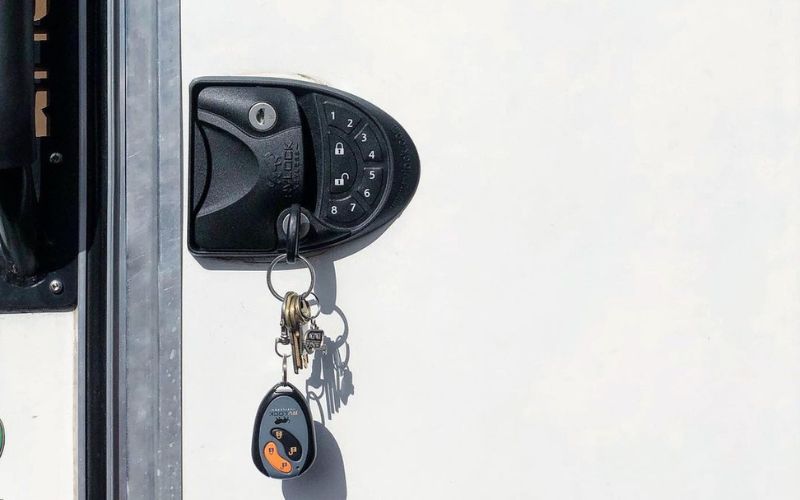
High Security RV Door Locks To Protect Your Camper from Theft and Break-Ins

Efficient RV Wood Stoves: Stay Cozy On The Road
Start typing and press Enter to search

Weight Distribution Trailer Hitches for Towing Campers and RVs
Why do you need a weight distributing hitch.
A weight distribution hitch does just what the name says — it evenly distributes the weight of your payload. It works by using adjustable spring bars and tension to distribute the load of the trailer tongue to the trailer and the tow vehicle axles. Weight distribution hitches, in most cases, allow you back up without disconnecting from your camper. Shop our weight distributing hitches for towing campers and RVs: from SwayPro ™, TrackPro ™, and 2-Point ™ for trailer sway prevention and towing control .

What Does Trailer Tongue Weight Mean?
The tongue weight is the static force the trailer tongue exerts on the hitch ball. For instance, if a 2,000-pound conventional trailer is loaded with 1,000 pounds of cargo, the proper tongue weight of the loaded trailer should be between 300 and 450 pounds or 10-15 percent of the loaded 3,000-pound total. A tongue scale will confirm actual tongue weight.
Weight Distributing Hitches
Select the hitch that is right for you.
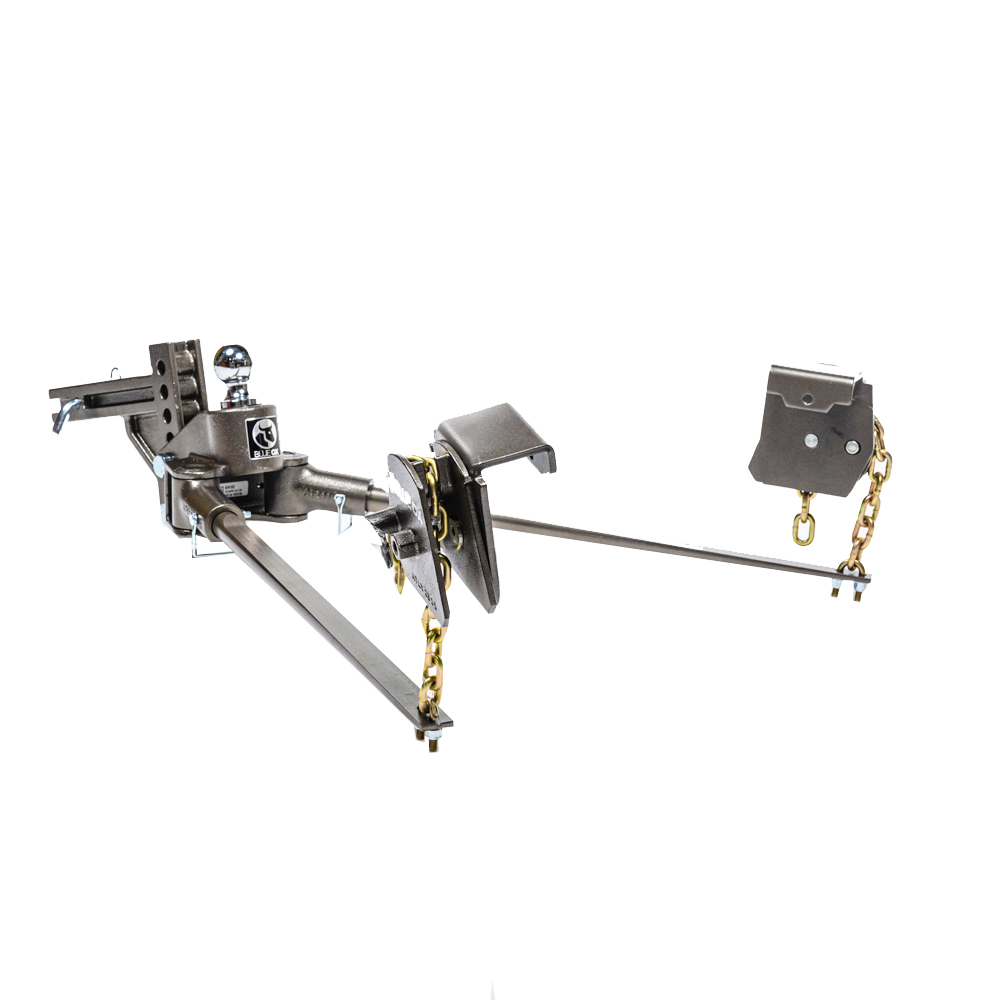
Premium Sway Prevention
- Evenly distributes weight over axles of the tow vehicle and trailer
- Noise-free sway prevention never stops working, even in rain or snow
- Caster in the hitch head constantly centers the trailer
- Spring bars augment the suspensions of the tow vehicle & trailer
- Rotating latches with clamp-on brackets for quick and easy setup
- Back up without disconnecting
- Powder coat over e-coat finish
- Steel construction
Specifications:
- Tongue weights available: 350, 550, 750, 1000, 1500 & 2000lbs
- Gross Towing Weight 20K maximum
- 2” receiver, 2-1/2” receiver shank available
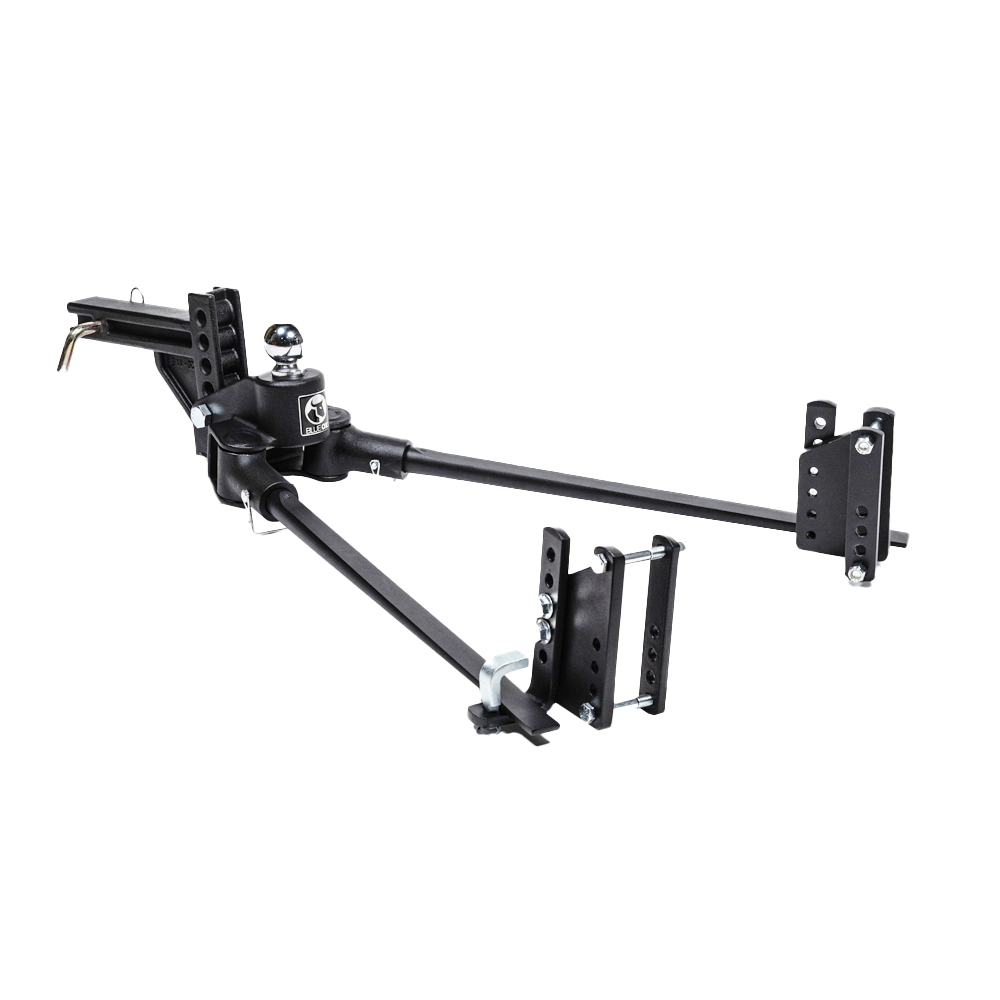
Premium Sway Management
- Manages sway caused by bad roads, wind, and weather
- Rigid L-brackets provide additional points of sway-controlling friction
- Tongue weights available: 600, 800, 1000 & 1300lbs
- Gross towing weight: 13K maximum
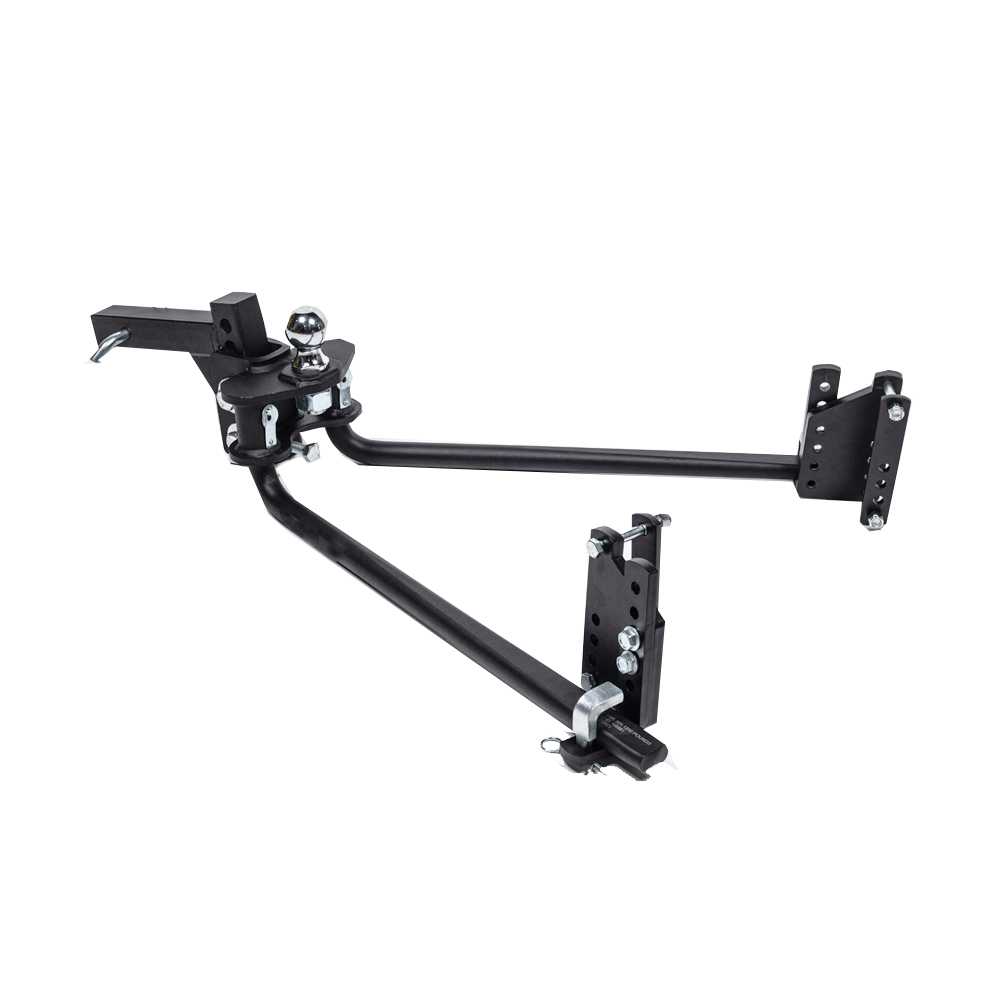
Best Value Sway Control
- Steel-on-steel friction minimizes sway. Round spring bars flex for a controlled ride
- L-Brackets keep spring bars in place Clamp-on brackets
- Tongue weights available: 600 (2-inch ball), 800, and 1200 lbs (2-5/16” ball).
- Gross towing weight: 12K maximum
- 2” receiver
All Weight Distribuition Products
Bx4330 acclaim tow bar (ball coupler).
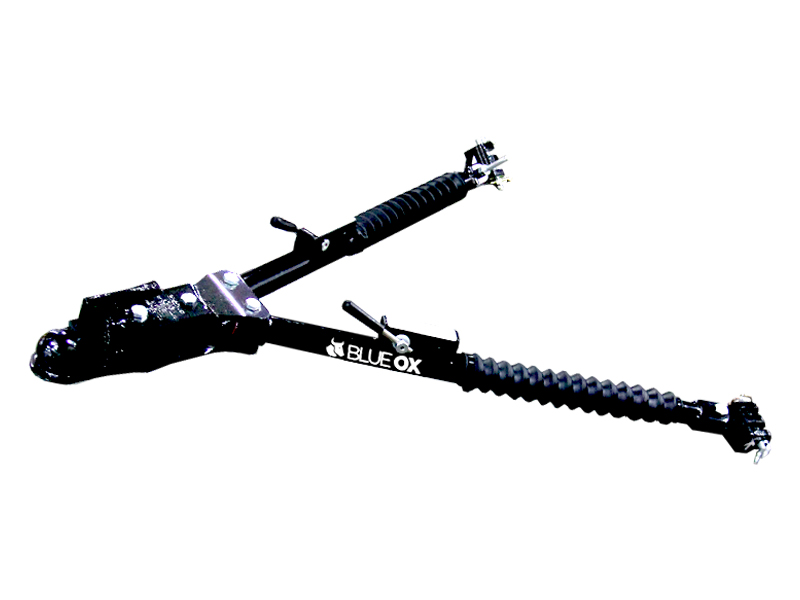
BX4370 Ascent Tow Bar (2″ Receiver)
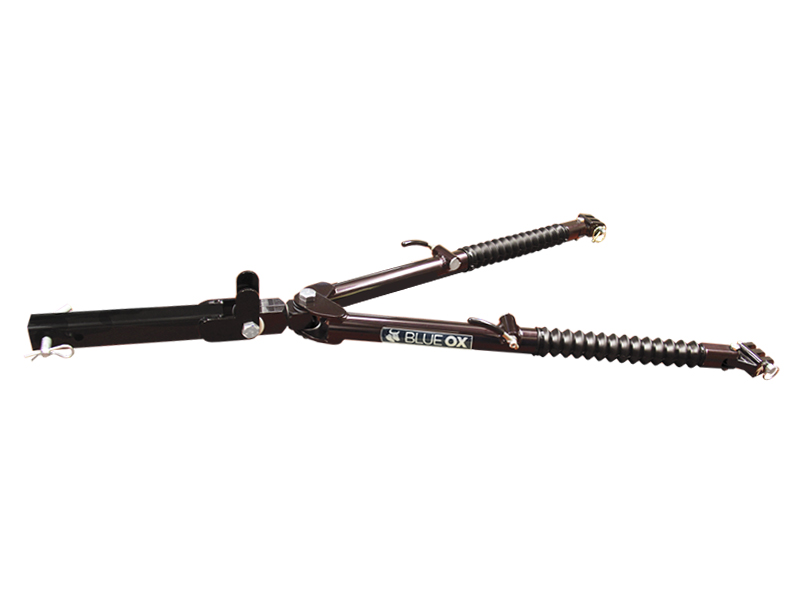
BX4375 Ascent Tow Bar (2.5″ Receiver)

BX7322 Adventurer Tow Bar (Ball Coupler)
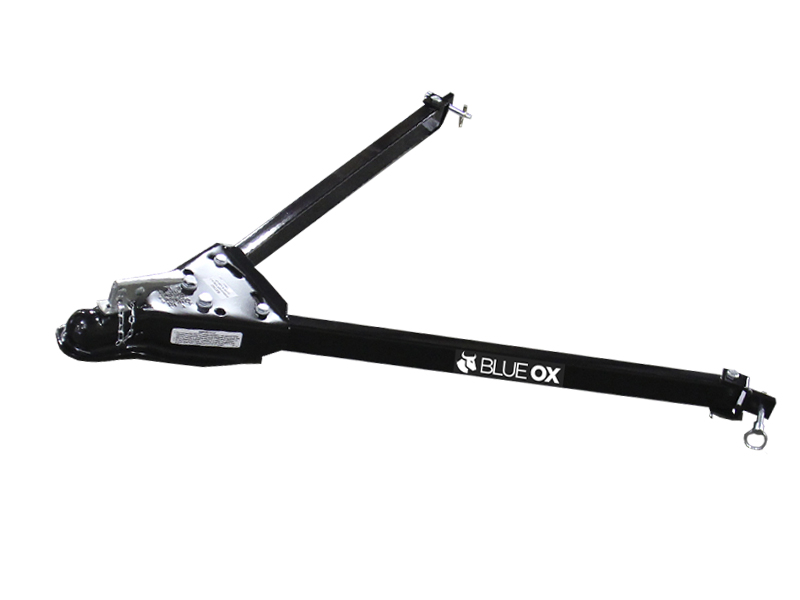
BX7380 Alpha 2 Tow Bar (2″ Receiver)
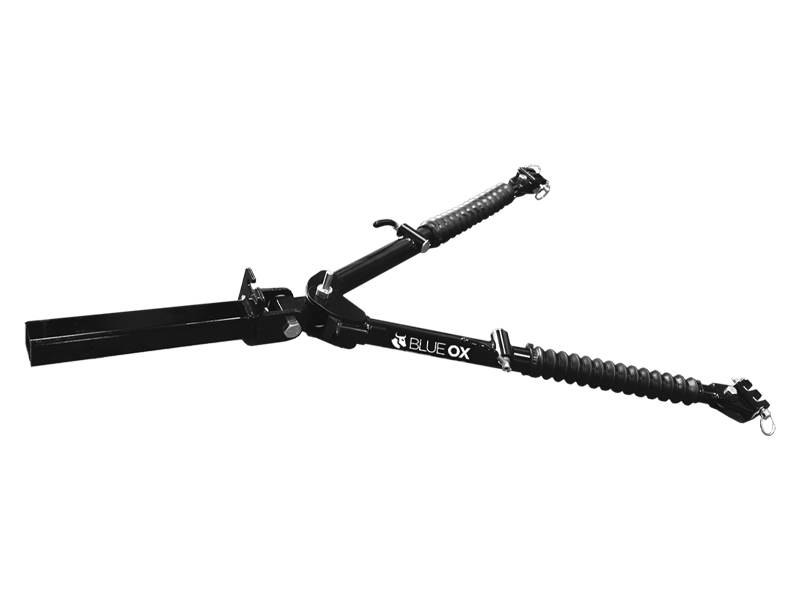
BX7420 Avail Tow Bar (2″ Receiver)
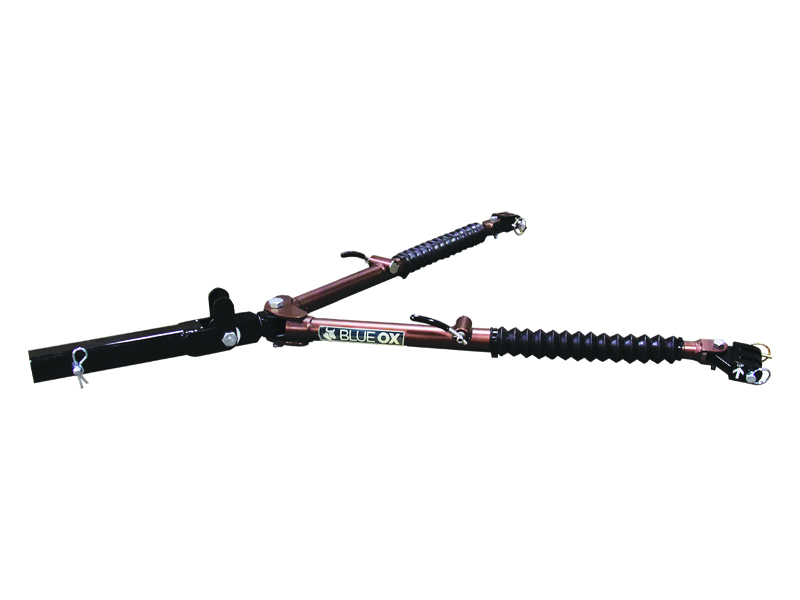
BX7425 Avail Tow Bar (2.5″ Receiver)
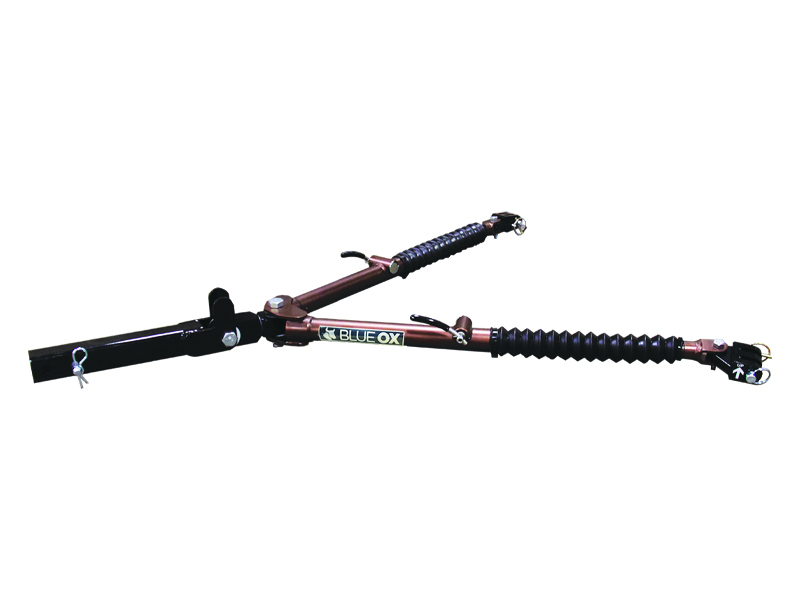
BX7460P Allure Tow Bar (Pintle)
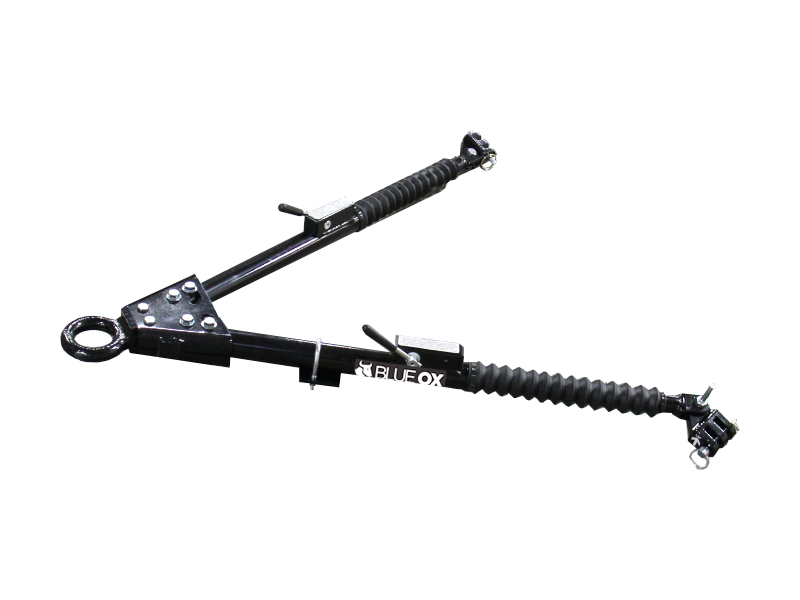
BX7470 Apollo Tow Bar (2.5″ Receiver)
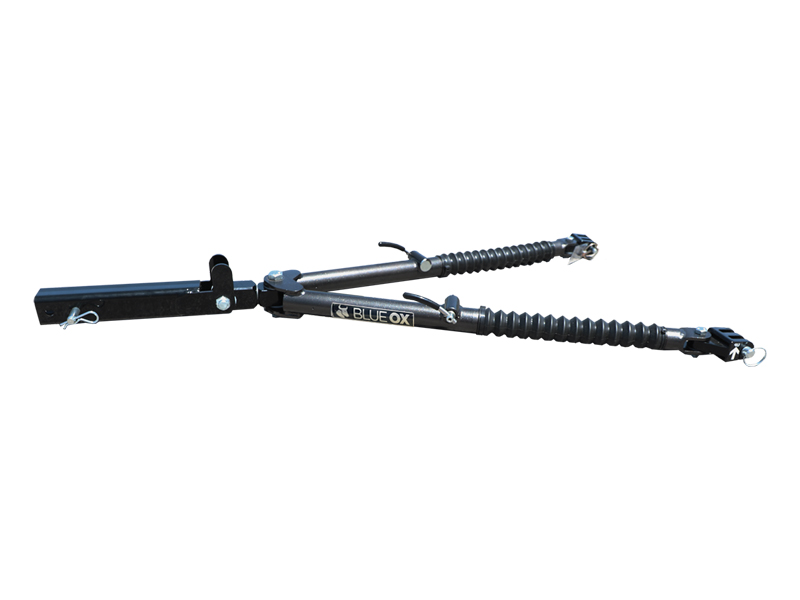
BX7475 Apollo Tow Bar 2″ Receiver
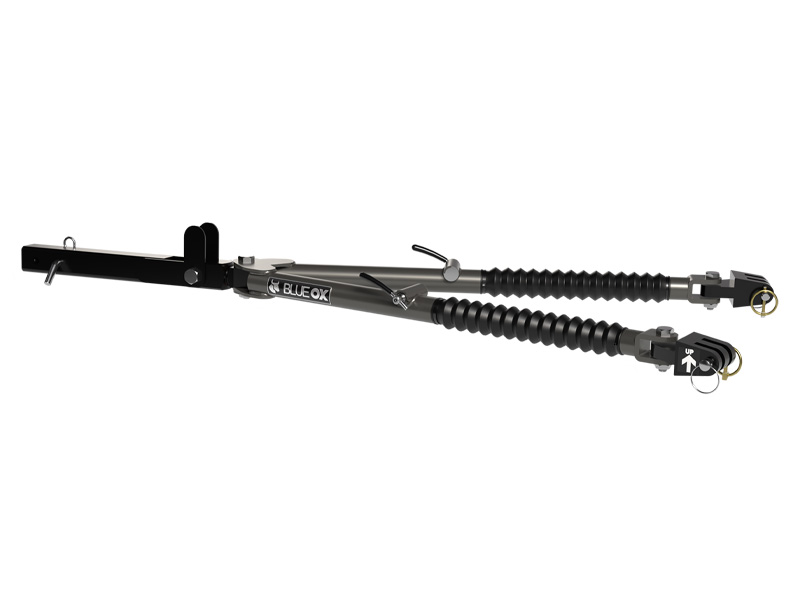
BX7520P Trion 20K Tow Bar (Pintle)
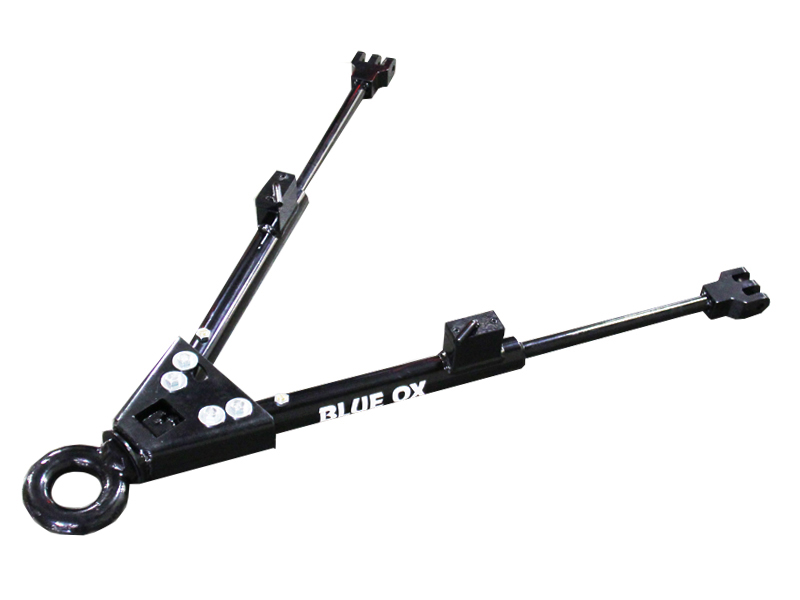
Weight Distribution Hitch FAQs
A weight distribution hitch is a towing system that evenly distributes the tongue weight of a trailer across the tow vehicle’s axles, preventing trailer sway and improving stability and control.
Read the installation instructions for your hitch thoroughly. Set the hitch ball height of the hitch head per instructions. Install the frame brackets per the installation instructions. Attach the hitch head to the tow vehicle’s receiver. Connect spring bars to the hitch head. Attach the trailer to the hitch head and raise the trailer coupler with the tongue jack. Connect spring bars to trailer brackets. Learn how to install the Trackpro Weight Distribution Hitch .
No, it doesn’t increase the towing capacity. It improves stability and control while towing within your vehicle’s limits.
A weight distribution hitch works by distributing the weight more evenly to the tow vehicle . It uses spring bars and brackets to spread the trailer’s tongue weight across both the trailer and tow vehicle’s axles, reducing sway and improving balance. Learn more about how a weight distribution hitch works .
No, it doesn’t reduce tongue weight; it redistributes it across the axles for better balance. Learn more on our guide to measuring tongue weight .
When towing anything 5,000 pounds or more, especially a travel trailer, installing a weight distribution hitch can make a massive difference in your towing experience by improving safety and stability. Most of the midsize and half-ton trucks out there will require a weight distribution hitch when towing something that is 5,000 pounds or more. Heavy duty trucks can vary a bit, ranging from 6,000 pounds to 8,500 pounds. Learn more about deciding whether you need a weight distributing hitch or not .
How Much Can You Tow?
If your receiver hitch is rated for use with weight distribution, the weight distribution system will allow you to tow at the maximum capacity of the receiver hitch. Weight distribution doesn’t “increase” your receiver’s capacity so much as it will enable the hitch to be used at its maximum capacity.
Generally, most people who choose to tow something try to keep the total weight at around 80 percent of their vehicle’s maximum towing capacity. This is the best way to make sure you don’t cause damage to your vehicle or increase the potential for accidents or difficulty hauling the trailer.
What Happens if You Tow More Than Capacity?
Max towing capacity should not be taken lightly. Exceeding what your vehicle is designed to tow can strain your engine and transmission, accelerate brake wear, damage your tires, and even warp your chassis. This could trigger catastrophic failure while driving and lead to property damage or severe injury.
Support Your Local Dealer
Featured blogs.
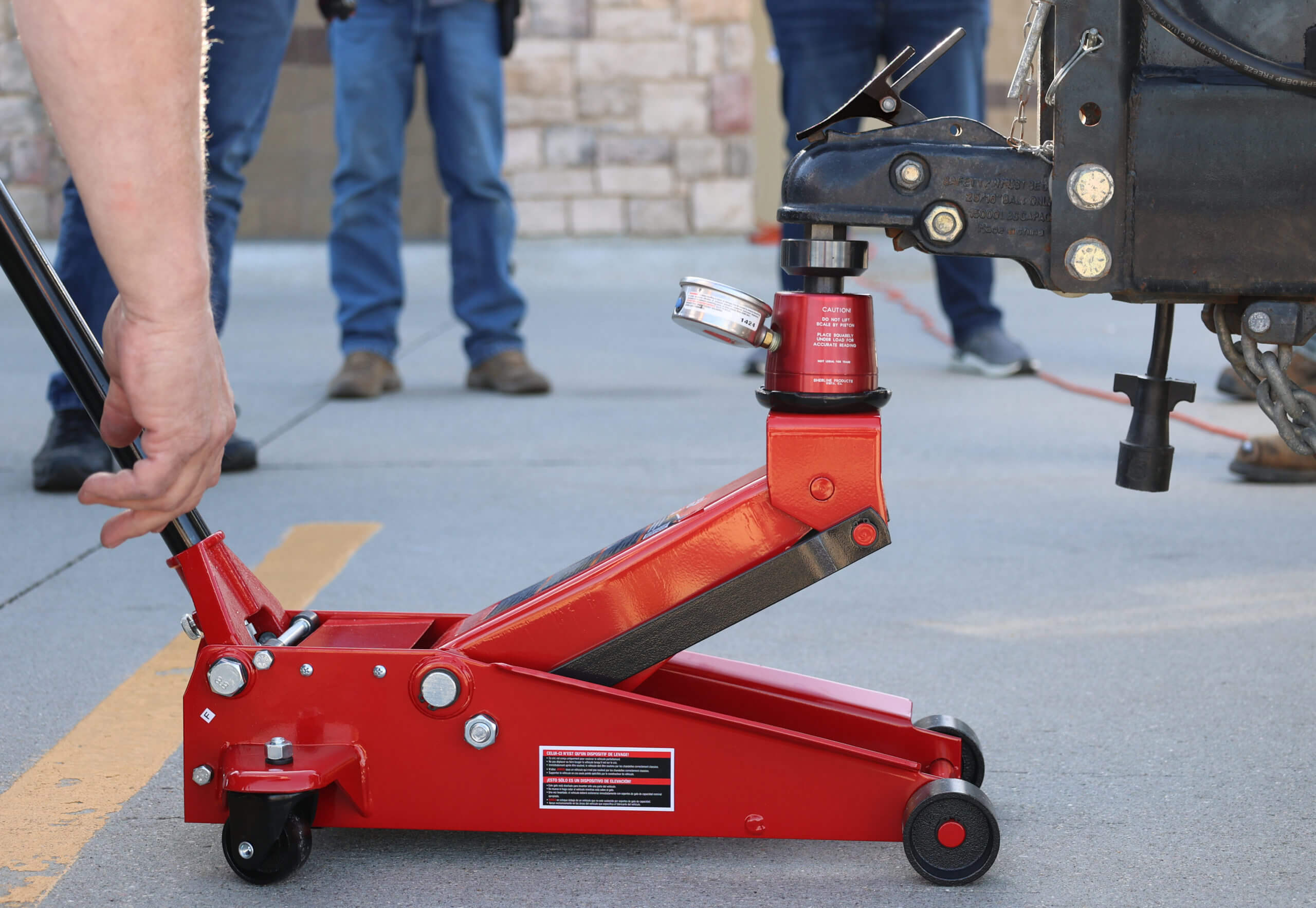
Guide to Measuring Tongue Weight
Making sure you understand the various weight needs and limitations associated with your rig is one of the most important things you can do to keep your family and yourself safe while towing a travel [...]
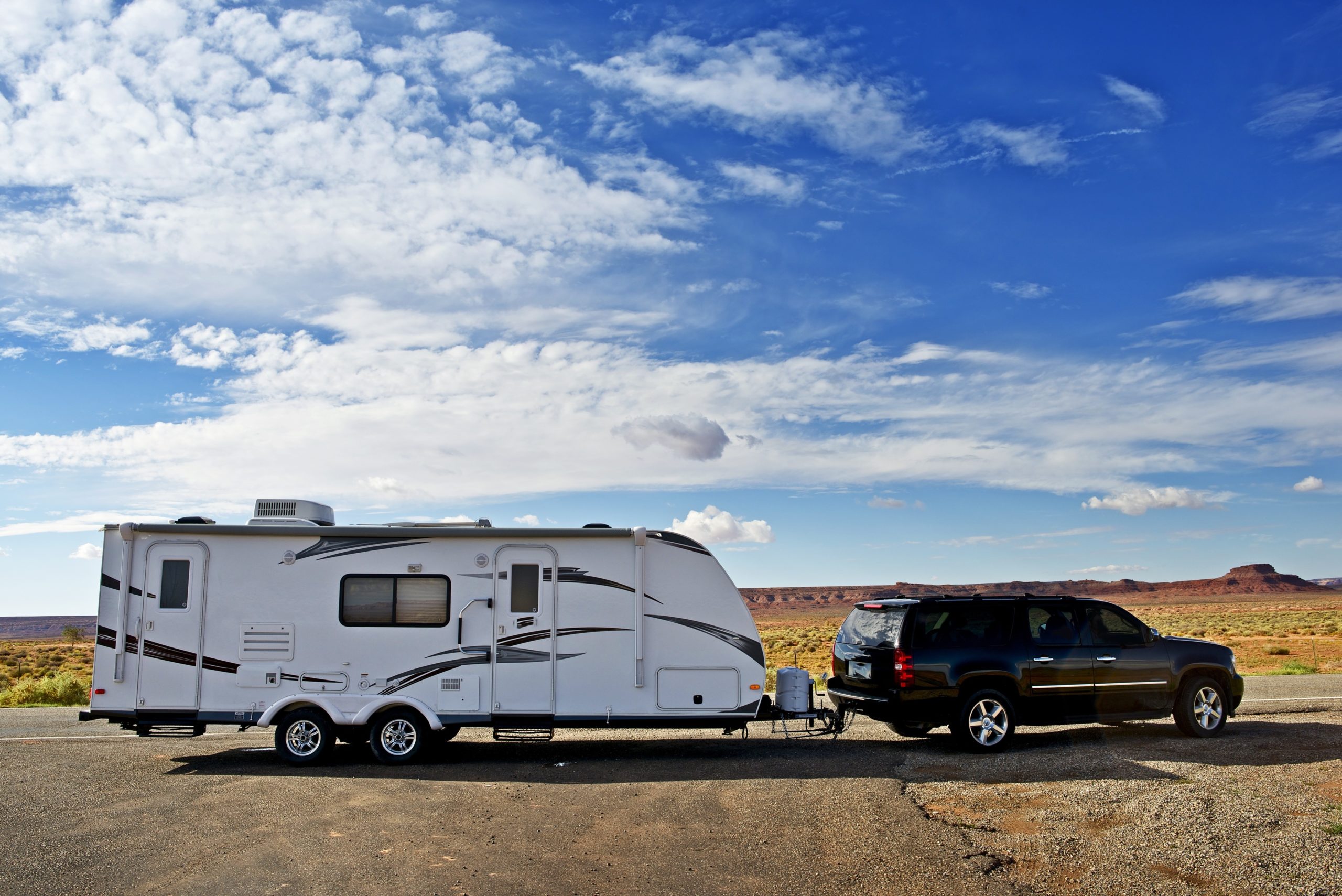
Do I Need a Weight Distribution Hitch for My Trailer?
If the words “weight distribution hitch” have you a little bit confused or if you’re wondering, “do I need a weight distribution hitch for my trailer” then this article i[...]
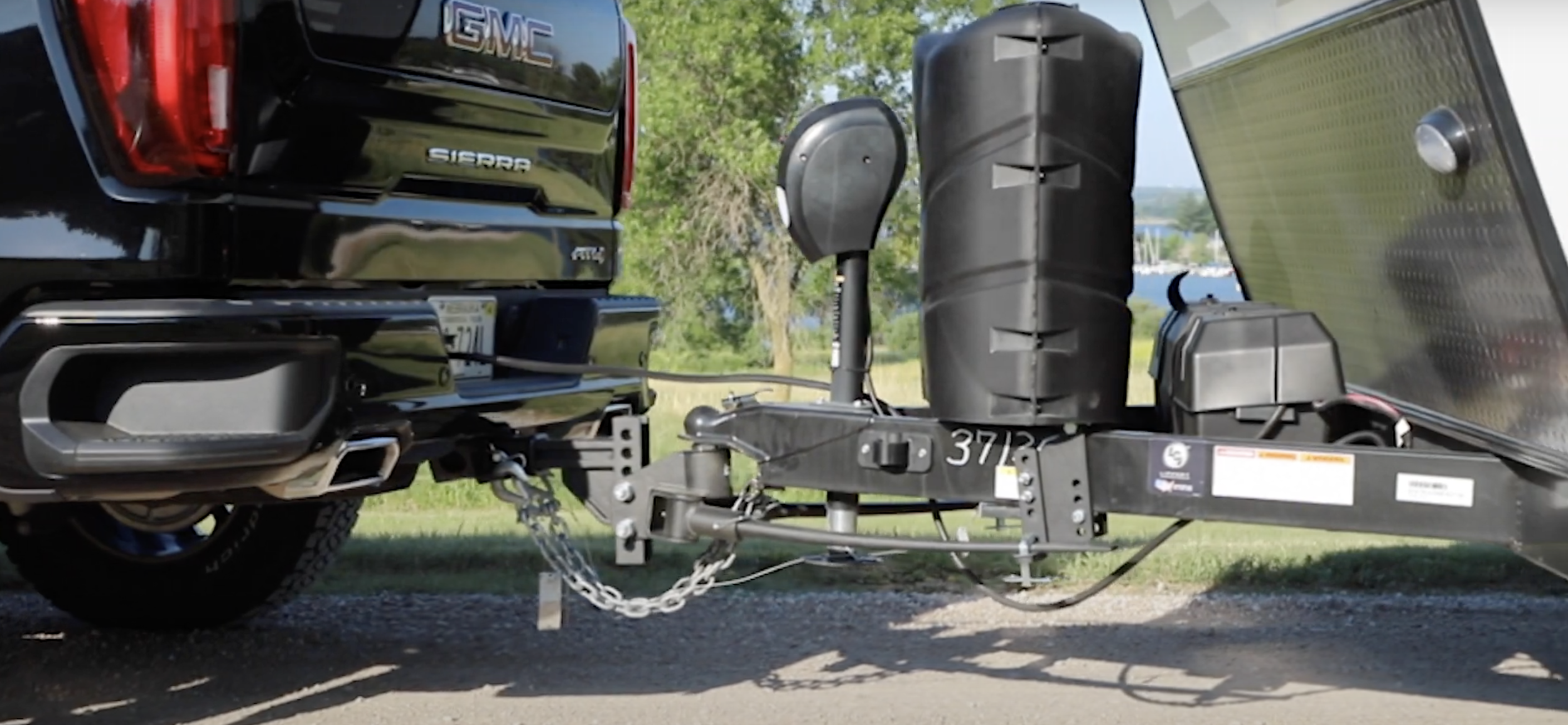
Trailer Sway Management for All Driving Conditions
When you are headed down the road with a trailer in tow, you want to be sure you are keeping any trailer sway under control with proper trailer sway management equipment. If you’re experienced w[...]

How to Install Sway Pro
The SwayPro is an innovative product that is a weight-distribution hitch that also prevents trailer sway. It does this by using loaded spring bars, easy to use rotating latches, and an integrated hitc[...]

How To Prevent Trailer Sway
Whether you’re a seasoned driver with years of experience or you’re just learning the ins and outs of pulling a trailer, everyone should be aware of the danger of trailer sway and how to p[...]

8 Ways SwayPro Is User-Friendly
When you’re out on the open road, traveling with your family, trailer in tow, you want the safest towing experience possible. Trailer sway is one of the leading causes of accidents involving trailer[...]
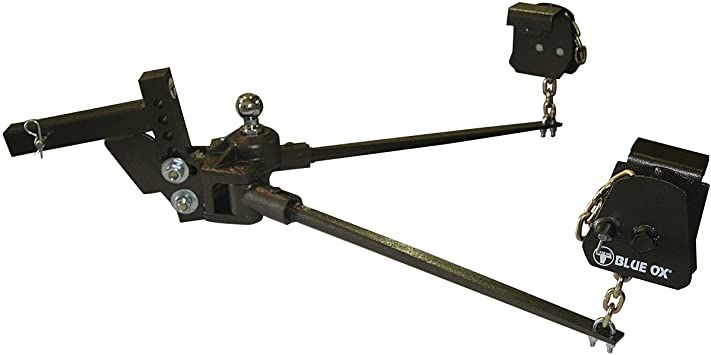
How Do You Know Which SwayPro Is Right For You?
Trailer sway is something we all want to avoid when traveling on the road with a trailer in tow. With SwayPro by Blue Ox, you can stop sway before it starts. But how do you know which SwayPro is right[...]

5 Ways Blue Ox Can Help with Sway Prevention
There are few things more frightening than when you are towing a trailer and you start to experience trailer sway. Maybe it is a rainy and windy day, or an 18-wheeler just passed you and you feel the [...]
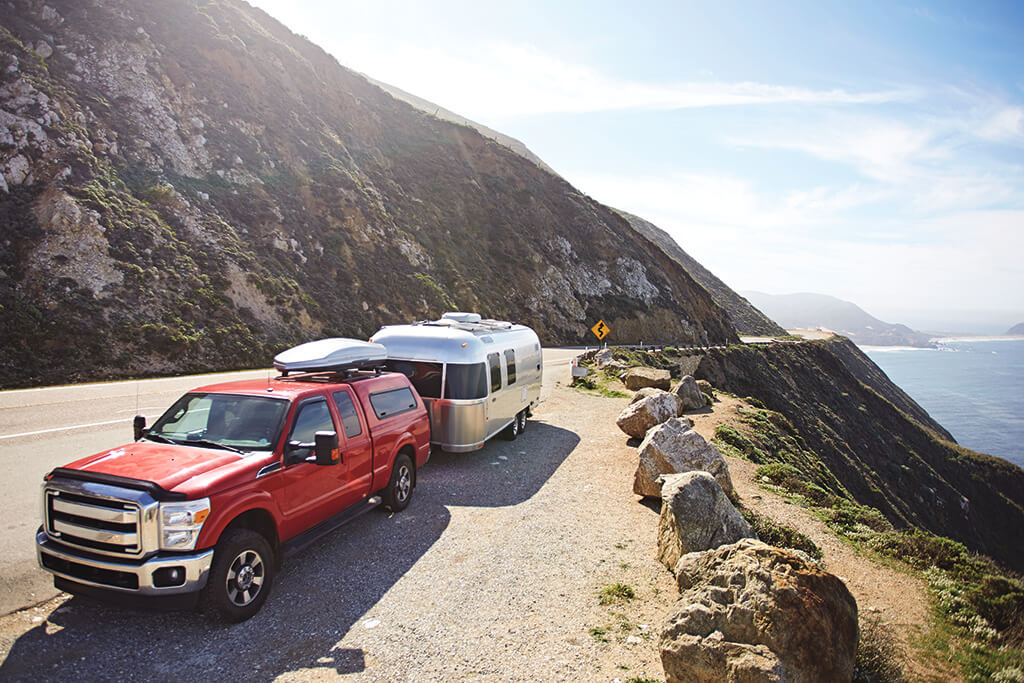
What To Do When Trailer Sway Starts
No matter how much trailer towing experience you may have, any driver can experience loss of control over their trailer without warning. And if you have ever experienced that scary moment when trailer[...]

ProPride 3P® Trailer Sway Control Hitch Trailer Sway Control Hitch
The ProPride 3P® hitch is the most advanced trailer sway control hitch available for your towing needs. Jim Hensley hitch , the man who revolutionized hitch performance with his old Hensley Arrow hitch design, has improved and enhanced his new anti sway trailer hitch design for your extraordinary towing experience. With easy installation and use you'll experience towing stability and safety unmatched by any hitch available.
Anti-Sway Trailer Hitch Specifications
- Solid steel, durable design and construction
- Patented yoke to eliminate trailer movement on the ball - even in panic stops
- 3/4" thick Pivot Point Projection control links
- 2000# rated weight distribution jacks
- 1400# or 1000# weight distributing spring bars
- LIFETIME WARRANTY
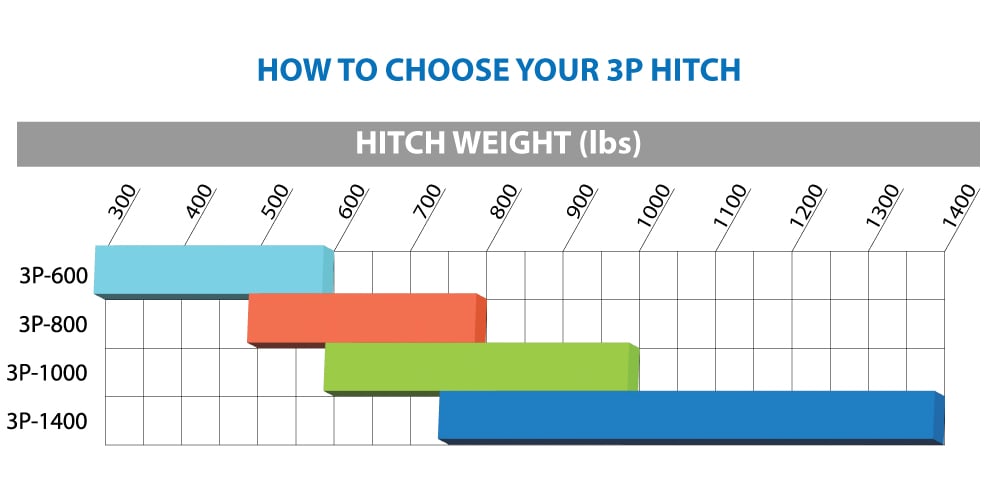
ProPride 3P® Main Unit
The ProPride 3P® anti sway trailer hitch main unit consists of two 3/4" thick links that project the pivot point of the trailer forward to near the rear axle of your tow vehicle. By not allowing the trailer to pivot side-to-side on the ball trailer sway is eliminated.
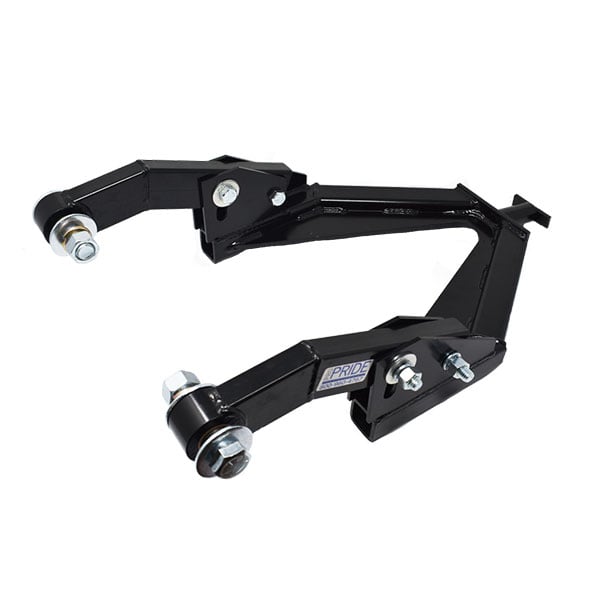
ProPride 3P® Yoke
The ProPride anti sway trailer hitch yoke keeps the main unit hitch ball from pivoting in the trailer coupler which would allow the trailer to sway.
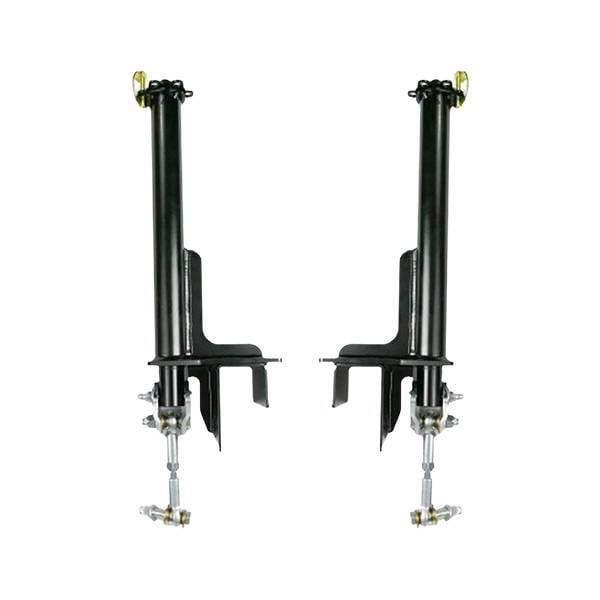
ProPride 3P® Weight Distribution Jacks
Heavy-duty ProPride 3P® weight distribution jacks allow you to distribute your tongue weight with precision and ease.
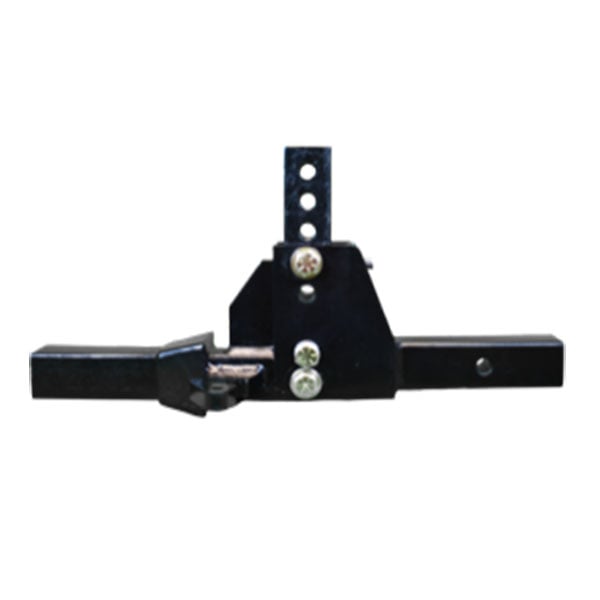
ProPride Adjustable Hitch Bar
Ready to eliminate trailer sway.
- See All Reviews

Fastway e2® Weight Distribution Hitch
For the best and safest towing experience, you need the e2® hitch, providing you with faster and easier weight distribution and sway control.
The e2® hitch gives you faster and easier sway control and weight distribution without the hassle of chains or add-on sway bars. With its built-in sway control, the e2 hitch has no backing, turning, or weather restrictions - when you need sway control the most. Its rigid brackets give you permanent sway control for smarter, safer towing. For the best hitch setup and safest tow, we recommend you purchase from our dealers . We have strong partnerships with our skilled and knowledgeable dealers, who can help you choose the best hitch for your truck and trailer. After identifying the hitch, they can properly install the hitch on your trailer, and provide in-person education on hitching, unhitching, and maintenance.
If there isn't a dealer near you, we are happy to assist. Please contact our customer service team if you have questions before you purchase.
- Starting At $ 555.0
- Preorder Now

CONFIRM PREORDER
The Fastway e2® weight distribution hitch offers faster and easier sway control and weight distribution. With built-in, permanent sway control, you can hitch up, tow, and unhitch with ease. There is nothing extra to connect or store, and nothing to remove when backing or making a tight turn.
The e2's rigid brackets provide two points of steel-on-steel friction, constantly working to fight sway. Its unique design provides a level ride while minimizing sway caused by winds, semi trailers and sudden maneuvers. The e2 hitch comes in round-bar and trunnion styles. Both offer fast and easy sway control and weight distribution. The e2's smart design can be installed around gas tanks and battery boxes, works with surge brakes, and can accommodate any trailer type.
Helpful Resources for the Fastway e2® Weight Distribution Hitch
How to install the e2® Hitch
e2® Round Bar Hitch Owners Manual
e2® Trunnion Bar Owners Manual
e2® Hitch Replacement Parts
Specifications
The Fastway® e2™ Weight Distribution Hitch comes in round bar and trunnion styles. Both offer fast and easy built-in sway control and weight distribution. If ground clearance is a consideration in your setup, one of the e2 trunnion hitches will work great for you. Below are the hitches we offer in both the round bar and trunnion styles:
*Includes 2 5/16″ hitch ball installed
Trunnion Style Hitches
Round bar style hitches, customer reviews.
Bought your 10,000 lb weight distribution hitch for our 35' long, 6,800 lb travel trailer. Towed it about 30 miles on 4/13/18 from storage to our house in winds gusting up to 50 mph. It performed perfectly. The next day was a 2.5 hour pull to our campground NE of Columbus, Ohio. I couldn't not believe how effortless the pull was. At times I was literally able to have one hand on the steering wheel if needed. Thanks for this great product!
- Written By: Don R.
- Apr. 16, 2018
Installed the e2 6,000 lb trunnion hitch for an 18 ft travel trailer. Pulling it with a 2015 Tacoma V6. Works great! Got the setup right on the first try. Instructions were very good. Happy with the product.
- Written By: Dave L.
- Feb. 27, 2018
Absolutely love the product. Towed my 25 ft toy hauler across the country and all over the south with it. No problems and it makes a great towing experience!
- Written By: Cindy
- Sep. 06, 2017
Our friends recommended that we get the e2 trunnion hitch for our 26 ft Jayco mated to our F150. Everything has been great. It is easy to hook up and disconnect, and when pulling, the trailer is stable and we have no swaying of any kind.
- Written By: Perry and Kathy
- Apr. 03, 2018
Love my weight distribution hitch. Does everything I expect of it. Easy on and easy off. No chains to remove when backing up.
- Written By: Jack H.
- Oct. 12, 2017
I've been getting peace of mind and safety using my Fastway e2 hitch for a few years. Now I've had to use their Customer Service. I got fast, intelligent answers, good news, and quick service. Got to be one of the best customer service departments I've ever dealt with. Thank you, Fastway.
- Written By: Carol B.
- Dec. 10, 2016
No more chains and sway bars. Love it. Easy on and off. Good quality too. Install was easy. Awesome product.
- Written By: Kris Y.
- Apr. 07, 2018
Since we got our trailer over 1.5 years ago, we used e2 weight distribution system and I'm so satisfied and happy about it. Fastway is the Rightway!
- Written By: Obeng O.
- Aug. 18, 2017
Can't tell you how much I trust your hitch. Even the 8,000 lb hitch has the truck and trailer level. If I ever get a heavier rig, I will most certainly buy another hitch from you guys. Again, thank you.
- Written By: Chris G.
- Apr. 13, 2017
Hello, just wanted to say I love my trunnion e2 hitch. First time towing a travel trailer, and the hitch has helped boost my confidence.
- Written By: Eric B.
- Jun. 08, 2017
We have been using your weight distribution hitch for our 31 ft. Komfort trailer for 10 years now... Never a worry or an issue this entire time. We feel very safe in our 37 states we have visited so far.
- Written By: Roger S.
- Jan. 30, 2018

8 Best Weight Distribution Hitches with Sway Control
Sure, your pickup truck has a sufficient tow rating for that travel trailer you have your sights on, but is that all you should be concerned about?
A weight distribution hitch with sway control is not always a requirement, but there are few better ways of protecting that brand new (to you) Silverado 1500, and your (future) cozy camper. The additional stability could mean the difference between a long white-knuckled trip and the family camping vacation of a lifetime.

A weight distribution hitch is essentially a contraption that reduces the weight being applied to the tongue of the tow vehicle through the power of leverage. This is desirable to level the trailer and truck, and required when nearing or exceeding (not recommended) the truck’s rated tongue capacity.
Sway control is typically a device added to a weight distribution system that uses friction to increase the amount of force required for the trailer to pivot around the attachment point. This helps to prevent lane wandering and control sway back and forth (hence the name). It can be especially helpful in high winds and when navigating mountainous roads.
Table of Contents
Top Weight Distribution Hitch with Sway Control in 2024
1. eaz lift 48058 : best elite trailer equalizer hitch.
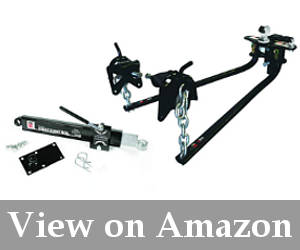
The assembly comes with the typical-diameter (2-5/16-inch) hitch ball, a perfect anti sway appliance with U-bolts, as well as the chains beneficially pre-installed. That’s why, the sway prevention set is easy to mount and pretty flexible, providing a 6-inch height setting .
Interesting information
The weight distribution system is produced by the famous Camco Manufacturing, Inc. that is an experienced company, producing various automotive accessories, including towing products since 1966 . It’s a US-based producer, with the headquarter in North Carolina . Having got 5 manufacturing facilities in the USA and one in China, the company is proud of its top-quality products, superior service, and competitive pricing .
Thus, the hitch is really durable. The shank is made of the strongest steel. It has 4 holes, so no drilling is required anymore. The weight distribution hitch is hefty and heavy-weight. Meanwhile, it may require some adjustments, as only the basic parts, including the sway ball, but not the hardware, are made of steel. The bolts, washers, and nuts are a bit flimsy, as usual, so you may use them or buy and utilize the most reliable ones.
The sway prevention hitch is covered by a 5-year warranty , that is quite moderate for the industry. It works quietly and pretty forcibly, being virtually the best equalizer hitch, meeting the basic towing needs and requirements.
- adjustable;
- no-drill installation;
- made of steel.
- some flimsy parts or hardware are included.
2. Blue Ox BXW1500 : Best High-Capacity Sway Control Hitch

The weight leveling kit is proudly produced in the USA (in Pender, NE state), in a factory with a longtime experience that started working since the early 1980s as Automatic Equipment Co. This prominent producer stands out by the top quality and sophisticated, open design hauling products. Consisting of spring bars, latches, brackets and pre-adjusted, easy-to-use heads, they are geometrically optimized, well-built.
Features and Specifications
Any additional adjustments are not necessary. The heads are open, providing easy access to the ball to tighten it. The torsion bars are beneficially made of top-grade steel, being able to flex and rotate 90 degrees. They are self-locking, including no extra pins or clips, able to back up, requiring no stops to fix the chains.
Thus, being virtually the best weight distribution and impactful sway control hitch, the device is intuitive to setup . Very good instructional videos can be watched on the manufacturer’s website. Additionally, the system enables the best possible usability, driving stability and handling improvement .
It completely eliminates sway, even in strong winds , providing amazingly smooth, safe, quiet rides. Generally, I guess, it’s the best self-adjusting weight distribution hitch with reliable sway control, high-capacity, long-lasting and noiseless.
The sway prevention system keeps the caravan perfectly centered. It fits minivans and pickups up to ¾ tons rating, like F150 or Chevy 2500 HD.
- fast to setup, hook and disconnect;
- lifetime warranty;
- all-weather no-sway results;
- inter-changeable torsion bars.
- you can get grease from the hitch while putting it on;
- the U-bolts may wear out during heavy use and require replacement.
3. Andersen Mfg 3350 : Best Universal Anti Sway Hitch

Andersen Hitches is a US-based, family-owned company that has 50+ years of faultless experience. Having got an innovative and spacious fabrication complex in Idaho Falls , the brand is famous for its top-quality products and unique technologies.
Thus, the weight distribution hitch is revolutionary in terms of technologies and materials. The kit is sway eliminating, anti-bounce, providing really smooth and noiseless trailer’s towing. It’s based on motion-dampening mechanism, including the patented springs, made of urethane .
Useful information
The installation and handling are amazingly easy due to the light assembly’s weight. The complete setup may take no more than half an hour. The sway eliminating set includes the standard, 2-5/16 ball that moves with the coupler, requiring no grease. The brackets and essential hardware are enclosed.
The hitch fits the 5-6-inch frame caravan’s brackets , rising and setting the bars. A clear and complete fitment guide is provided on the manufacturer’s website. The system provides 4-inch drop/rise , following the situation on the road. Finally, to remove it, just pull the pin out.
- lightweight;
- simple, innovative design;
- intuitive to install and remove;
- anti-bounce.
- it can make an unpleasant sound when turning a tight corner;
- the plastic insert and bushings may require replacement in some years.
4. Reese 66559 : Best Trunnion, RV Weight Distribution Hitch

The sway control kit prevents wagging and pitching , being virtually quiet during the hauling. It improves the truck’s brake control and handling, evenly apportioning the load forces.
Useful accessories
The weight distribution appliance features the thick, 30-inch spring bars, the lifting brackets, a steady-flex trunnion head, being powder-coated, sleek and long-lasting. Even the hardware is solid and reliable that is not common for the sets of automobile parts and accessories. Lifetime warranty speaks for the system’s durability.
Standing out by significant weight that makes about 93 pounds , the sway control assembly is hefty. All your family members or several friends would come together to carry it to the garage. The distribution hitch is produced under Reese brand by the famous Horizon Global Corporation that started operation in 1952 in North America (Plymouth, MI) that is recognized as the premium towing systems’ manufacturer. So, I think, this weight apportioning kit is produced in the USA , being reliable and top-quality. I highlight it among the best sway control systems thanks to its usability and durability.
The weight distribution device accurately fits 2” receivers and (according to the producer’s website) 5”-7” frames when it does about top-mount couplers. Bottom-mount ones work also on the 4” frames perfectly well. The hitch is fast to install, easy to connect and uncouple. The installation video and the guide are freely accessible, helping with the mounting perfectly well.
However, the top-quality, highly-efficient hitch also has some drawbacks. The hitch ball isn’t sent with the parcel. The part is to fit the sway prevention system, being 1-1/4-inch in diameter. Additionally, the powder coating is thick and available inside the threads. It might eliminate corrosion completely, but inserting the bolts isn’t the easiest actually, requiring applying some physical strength and a suitable torque wrench (3/4”-drive or 1/2”-drive).
- thick powder coat;
- easy to connect;
- no-drill, intuitive installation.
- the hitch ball is offered at additional cost.
5. Pro Series 49903 : Best Welded Weight Distribution Trailer Hitch
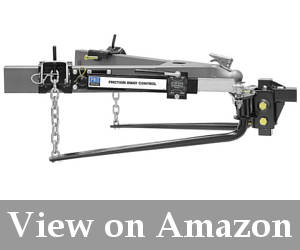
The weight transferring set is ready-to-mount, pre-installed, including a hitch and a sway balls, the essential hardware. The torsion devices and rounded, welded, made of top-grade, solid steel. An instructional video is available and it can help you significantly with the setup. The user manual is a bit complicated, unfortunately.
Additional information
So, the hitch is intuitive to collect and mount, easy to setup and use. The mounting commonly takes up to an hour. Just turn the washers and the rivet on the head, changing the tilt, according to the available trailer’s particularities. The shank’s height is also adjustable with the bolts easily.
Meanwhile, the weight distribution hitch is seemingly made in China, being delivered with a Reese label on it. I would say, it’s top-quality, well-designed and user-friendly, but it still may require frequent lubricating , for example, using a grease gun. The hitch can make some noise, especially by turning or backup.
- adjustable hitch’s head and bars;
- made of thick steel;
- 10-year manufacturer’s warranty;
- a bit noisy without lubrication;
- heavy-weight.
6. Curt Manufacturing 17007 : Best Load Leveling Hitch

The hitch is really well-designed, high-capacity and reliable. It’s not too heavy in terms of the weight, but able to handle up to 14,000 lbs . of weight totally. The sway prevention assembly includes 2” * 2” hitch heads, round bars, attachment tabs, an adjustable shank, the hardware. Additionally, it’s beneficially covered by limited lifetime manufacturer warranty (one-year on the finish and parts).
The bars are beneficially produced from steel, forged, powder-coated, to ensure the premium corrosion resistance, durability, and anti-scratch protection. It’s easy to setup and disconnect, as it requires only removing of the pin and clip.
More information
However, the hitch ball is absent in the parcel, and it’s necessary to buy a 2-5/16-inch one separately, preferably made by Curt Manufacturing , obtaining the best compatibility. A receiver lock can be bought optionally to protect the pin from being removed, making the hitch theft-proof.
As to the installation, it’s quite intuitive. But the manual is not completely clear for the beginners or the drivers, going to deal with towing for the first time. I would suggest putting the bottom adjustment bolt in at about 3 quarters and using 5 washers. The parts require some lubrication . Adjustment is pretty simple, taking only a couple of minutes and it can be performed on the road.
- simple-to-adjust;
- corrosion-resistant and durable;
- precise leveling abilities;
- heavy-duty heads included.
- a 2-5/16 ball is to be purchased additionally.
7. Camco Chem 48733 : Best Trailer Weight Distribution System

The hitch includes no chains, but it lets the trailer turn easily, performing flawlessly. The Recurve R6 sway control kit’s design is innovative, providing the premium ground clearance. It automatically disengages on tough corners or on the icy roads when you don’t need it. This way, it makes maneuvering much smoother than the similar weight distribution hitches allow.
Interesting benefits
The hitch looks subtle and sleek due to the black finish; it’s really massive and heavy-duty . The installation is not complicated or time-consuming. Only the instructions are a bit long and not too clear. The bar mounts are a bit flimsy, twisting excessively. Additionally, the lanyard pins are easy to lose. In this case, the manufacturer sends the replacement ones very fast.
- innovative design;
- highly efficient on the corners;
- heavy-weight;
- heavy-duty.
- common mounts and pins issues.
8. Equal-i-zer 90-00-1200 : Reliable Sway Control Hitch

75 years of dedication, make the company leading and reliable. Ed Hedgepeth founded it in 1945 in Utah. Initially, it worked as Mobile Manufacturing. Then moved from one city to another (Salt Lake City –Lindon – Provo). Nowadays, it gets special (reader’s choice) awards every year. It’s a reliable proof of the products’ quality and usability.
Having the hitch installed, you can drive safely. Any quick maneuver doesn’t cause lane wandering. Gusty winds don’t keep you from driving. 4-point hitch is unrivaled. It ensures the highest level of resistance to sway. It distributes the caravan’s weight to all axes. The accessory improves braking and steering.
Features and Benefits
The hitch consists of the strongest, high-grade American steel. It includes a pair of 12-inches long shanks and a head. Control brackets and 36”-long spring bars are its essential parts. Find a couple, two, three rivets, washers and installation hardware inside the parcel. Installation is intuitive. But the ball is not available. You’ll have to buy it additionally.
- heavy-duty;
- easy-to-use;
- intuitive to install;
- no ball included;
- might make some noise while turning.
Get more information by reading the recall forum users.
Buyer’s Guide
Is a weight leveling and distribution system an unnecessary gadget, recommended by obtrusive sellers or an essential towing accessory ? Let’s check it.
When Do You Require a Weight Distribution Hitch?
When you buy a caravan to go camping or sightseeing, you could mention that it’s quite large and heavy. Your pickup truck is definitely powerful and impressive, but its weight is significantly less (50%, at least) than the camper trailer’s tonnage. So, a towing device is commonly required by the vehicles’ manufacturers. It’s necessary to ensure all road users’ safety.
What Does a Weight Distribution Hitch Actually Do?
The set levels the caravan, transferring the weight to all axes, making the tongue be perfectly leveled. The advanced weight distribution kits stand out by the built-in sway reducing features . They provide the necessary towing safety, preventing lane wandering , making driving soft and quiet, improving the tow vehicle braking and steering.
Thus, selecting the best weight distribution and anti-sway hitch to haul the camper , consider:
- the necessary capacity;
- the kit’s ease of setting up and adjusting;
- the type of the torsion bar;
- the finish;
- availability of the basic parts.
The principal ratings, indicative of the weight distribution hitch’s performance are GTW and TW .
Gross (total) caravan’s weight or GTW shows the tonnage of the completely loaded trailer that is being towed.
TW (tongue caravan’s weight) designates the tongue mass, including the weight of the stuff delivered behind the rear tow vehicle’s axle, for example, in the pickup truck’s bed.
Tongue weight commonly makes from 9% to 11% (or up to 15%) of the trailer’s tonnage. Thus, before selecting the suitable system that performs weight carrying and distributing functions, it’s recommended to measure the loads delivered in the cargo area and inside the trailer. This way, you avoid raising or lowering the front truck’s end. The suitable-capacity weight distribution hitch provides level, well-controlled, smooth travel. The rating is to be indicated in your truck’s and the caravan’s owner manuals, and should never be exceeded.
Spring Bar Types For Weights
The weight distribution system commonly comes with one of 2 spring bar types , such as:
- round (intuitive to setup, providing better clearance);
- trunnion (standing out by higher load capacity).
The anti-sway option is essential to improve control and braking. Eliminating any risk of the trailer falling on harsh corners or bumps with the nearest vehicles due to abrupt wind or the trailer radius overbalance.
Carbide or black powder finish is preferable as it ensures great, sleek appearance and premium durability, making the hitch corrosion-resistant and high-performance.
All the weight distribution assemblies I recommend you are user-friendly and intuitive to setup. The installation takes up to half an hour, requiring only common tools and basic skills.
Finally, the pre-assembled kits that have all the essential parts included are preferable. Otherwise, compare the total weight distribution hitches’ costs, adding the optional components’ prices.
How to Properly Set Up the Delivered Weight Distribution Hitch?
The kit installed to the receiver commonly includes :
- a class 3,4 or 5 hitches (it should have a weight rating label attached);
- a head set;
- 2 bars with chains or without them;
- 2 lift brackets.
A hitch ball may be included or recommended to buy separately.
Thus, mounting the properly fitting weight distribution kit:
- level the caravan’s tongue, paralleling it with the parking field;
- mount the shank initially, then the hitch’s head and the ball;
- add the torsion bars.
- tighten the available bolts, connecting the weight distribution assembly.
How to Adjust the Pre-Installed Weight Distribution Hitch?
Level the tongue jack by tightening the ball or the brackets, either by lifting the chains and hooking them.
How to Prevent Bounces, Bumps, and Sway?
Being able to adjust a sway control bar (by connecting its end to your truck’s suspension) . Level both the caravan and the light truck and ensure the complete driving and towing safety. Above all, check the wagon’s weight. Using the scale of any kind. Subsequently, distribute the cargo weight correspondingly. All tires are to be equally inflated. Additionally, try to avoid abrupt winds.
Where to Buy a Hand-picked Weight Distribution Hitch?
How to buy a weight distributor and lifting device with the highest rating? First, you can visit the local auto parts store. Secondly, visit the nearest dealer of the manufacturer. And also to glance to the seller of the trailer or service center. The weight distribution set can be installed and adjusted there. But the prices on online shops or platforms like Amazon are more affordable. The information provided is complete and detailed.
Is a weight leveling and distribution system yet another unnecessary gadget or is it an essential towing accessory ? The answer is, of course: it depends. The single largest factor happens to be the weight being applied on the rear of the vehicle, and how that relates to the vehicle’s actual load capacity.
What Happens When Weight is Added to the Back of Your Pickup Truck?
Weight added to the truck bed at, or in front of the rear axle adds load to the front and rear axles that’s proportional to the distance it’s placed from the center of the two axles. Pickup trucks are designed to compensate for added load on the rear axle by being front-heavy (we discuss this in more detail in our Adding Weight to Your Truck Bed Buyer’s Guide).
Adding weight behind the rear axle also adds load to the rear axle, but in contrast, reduces the load on the front axle. This is fine…until it’s taken too far.
As you add weight to the tongue of your truck, you will notice that the rear end of the truck begins to “squat” – this is the suspension compressing under the load. When it gets to a certain point, you may notice the front of the vehicle begin to rise. As this happens, the ride and the handling dynamics of the truck change significantly.
Technically, a weight distribution hitch is required when you’re towing a trailer and the tongue weight is nearing or exceeds that of your truck’s rated capacity. That said, you may not know the actual numbers, or your situation may just be more complex.
What’s the simplest way to tell, visually? Hook up your trailer and look at your rig from the side. The truck should be sitting level, or with the rear slightly lower than the front, and the trailer should be sitting level. If the front of the truck is lifted significantly from its typical ride height, or if the truck and trailer form a “V,” you definitely need a weight distribution system (or you need to reevaluate your trailer).
The safest bet is to plan on using a weight distribution hitch if you’re towing a trailer or camper that is anywhere near your truck’s tow rating. It won’t hurt, and it can help ensure the safety of yourself and all those on the road around you.
A weight distribution hitch (or system) mechanically shifts some load from a truck’s rear axles to the front axles, and helps lift the front of the trailer being towed. For the mechanically inclined reader, the system is introducing a torque preload (in the vertical plane) at the hitch joint.
Properly distributing the load applied to the truck’s axles and leveling the whole rig greatly improves handling and helps prevent trailer sway or fishtailing, which can be catastrophic.
An anti-sway feature (might be built-in to the system you choose, or can be added) further dampens sway or lane wandering that can occur on the highway due to towing a large trailer or camper. This is accomplished by adding resistance to the left and right movement of the hitch joint (horizontal plane). This adds stability and increases driver comfort for long hauls on the highway, but likely must be removed for maneuvering in tight spaces.
What should you look for when selecting the best weight distribution and anti-sway hitch to haul your camper or other heavy trailer?
A few things to consider:
- The required tow capacity;
- the type of torsion bar;
- availability of replacement parts.
Two of the most important numbers to understand are GTW and TW .
Gross Trailer Weight or GTW represents the weight of the completely loaded trailer that is being towed.
Tongue weight or TW specifies the portion of the weight applied at the point of attachment (hitch). When a trailer is loaded properly, the tongue weight is typically between 9% and 15% of the gross trailer weight (GTW).
Before selecting a weight distribution system, it’s recommended that you determine your truck’s towing capacity and tongue weight rating, as well as the gross trailer weight and tongue weight of the trailer you wish to tow. These numbers will quickly narrow your product selection.
Spring Bar Types
The weight distribution system commonly comes with one of 2 spring bar types : round, and trunnion.
Round spring bars tend to be used in systems with lower weight ratings, are a bit more difficult to install, but are less expensive.
Trunnion bars typically have a higher weight rating, are easier to install, and provide more ground clearance.
Anti-Sway Option
Many weight distribution systems have the option to add, or come with an anti-sway system. An anti-sway option is a great addition to improve stability and comfort for long hauls.
All the weight distribution assemblies I recommend here are user-friendly and intuitive to set up. Installation can take up to half an hour and requires only common tools and basic skills.
- a class 3,4 or 5 hitch (it should have a weight rating label attached);
- 2 spring bars, with or without chains;
- 2 lift brackets;
- a hitch ball may be included.
Mounting your new weight distribution kit:
- use the jack foot to level or lift the tongue of the trailer slightly beyond level;
- add the torsion bars;
- tighten the available bolts, connecting the weight distribution assembly;
- slowly lower the jack foot until all of the trailer’s weight is on the truck;
- step back and check your rig from the side – if it is sufficiently level, you’re ready to roll;
Where Can You Buy a Weight Distribution Hitch?
First, you can visit the local auto parts store. Second, you can visit the nearest dealer or manufacturer. Many trailer and camper dealers also sell systems, and they will likely even do the install and adjustment. But the prices on online shops or platforms like Amazon are typically more affordable, and have the advantage of numerous public reviews.
Final Verdict
In my opinion, BXW 1500 by Blue Ox is a great weight distribution hitch with sway control due to its extremely high loading capacity and durability. The anti-sway system 3350 from Andersen is lightweight, but it is equipped with some flimsy, plastic parts. The hitch kit 66559 by Reese is one of my favorite accessories as it helps to eliminate any pitching or wagging even in crosswinds.
Great video explainer on how this works and how to set it up: https://www.youtube.com/watch?v=iGd7NSX9w_M
Related Posts
The best shocks for dodge ram 2500 diesel, long-lasting and performance, 7 best fender flares for ram 1500, rugged and stylish, leave a comment.
Your email address will not be published. Required fields are marked *
Save my name, email, and website in this browser for the next time I comment.

State Regulations Regarding Travel Trailers and Driving Laws
Natasha Japp Photography/Getty Images
If you plan to drive your RV or trailer on a state by state camping road trip , you'll want to know the laws of each state. We RVers go to great lengths to choose an RV that meets our needs and budget. We learn to drive or tow them with care. We insure them, make sure they’re registered and that we’re abiding by all the laws.
But one thing most of us don’t give much thought to is that when we cross a state line not only might the traffic and driving laws be different than in our home states, but the legal specifications for our RVs might be different, as well. These tips on regulations for RV laws and trailer by the state are intended to be helpful, but regulations change often and it is up to you to know and follow the law.
Some General Differences in State Driving Laws
In California , the speed limit on freeways is 55 mph for any vehicle towing a trailer and 70 without a trailer.
In New Jersey, if you are pulled over and found to have a firearm that was not purchased IN New Jersey, you are breaking the law.
The speed limit maximum in Texas is 70 mph during the day, and 65 at night. If you don’t take notice of this they will ticket you. It’s easy to do when leaving a state like Colorado where the speed limit maximum is 75 mph. I was pulled over in Texas one morning for going 72 mph.
New York doesn’t allow trailers at all on most parkways.
Some states don’t allow right turns on red lights, anywhere. Others allow them as a rule, and with only specific streets restricted.
Most speed laws become immediately apparent because they are usually posted prominently along the highways. But the right turn, towing regulations, propane limitations, and other types of laws are harder to know, because those are in the drivers’ handbook, but not necessarily posted so that out-of-state drivers would be aware of them.
But these aren’t the only differences in highway laws that can get you a citation and a fine.
Width Limits
Our older Airstream is only 8 feet wide. But newer ones are 8 feet 5.5 inches. But, did you know that these newer Airstreams are illegal, by a mere 5.5 inches, on highways in some states?
Alabama, Arizona, Washington D.C., Georgia, Illinois, Kentucky, Louisiana, Michigan, Missouri, New Hampshire, New Jersey, New Mexico, New York, Oklahoma, and Tennessee each have a width restriction for trailers of 8 feet.
In Connecticut width for RVs is limited to 7.5 feet, 8 feet high, length 24 feet and weight 7,300 pounds on the Merritt and Wilbur Parkways.
Length Limits
Alabama, in addition to having an 8-foot width limit also has a trailer limit of 40 feet.
If you plan to tow a trailer and a boat, or any combination of two tows, stay out of California.
Contrary to California, Arizona allows, with some restrictions, more than one trailer.
Trailers are limited to 32 feet on Mississippi’s Natchez Trace.
Brakes, Hitches
Several states have trailer brake and hitch requirements. Iowa requires equalizing hitches, sway control and brakes on all trailers over 3,000 pounds.
Minnesota requires trailers of 6,000 pounds or more to have breakaway brakes.
North Carolina requires an independent brake system for house trailers of 1,000 pounds or more.
Utah requires breakaway braking system if over 3,000 pounds.
Other Restrictions
If you’re traveling from Illinois to Iowa, route around the bridge between Fulton, IL, and Clinton, IA. Trailers are prohibited on that bridge.
If you have propane tanks (don’t we all?) you cannot pass through the Baltimore Harbor Tunnel or Fort McHenry Tunnel in Maryland.
If you’re planning a trip to Montana’s , find out what RV restrictions are in place first.
In Virginia, you’re limited to two portable bottled gas tanks of 45 pounds with valves closed in the Hampton Roads Bridge Tunnel, Chesapeake Bay Bridge Tunnel and the Norfolk-Portsmouth Tunnel.
And Wisconsin, under limited conditions allows riding in a fifth wheel.
Sorting It All Out
Planning a cross-country trip could be more work than you’d originally planned to do if you want to stay street-legal in all the states you’ll be traveling through. To be sure, look up the department of motor vehicles websites in the states you plan to travel through. Most have a way to apply for a permit or waiver if your rig doesn’t meet their laws. Having these on file as you travel through each state will make your trip go more smoothly. It is also good to know whether there are no waivers, too, so you can reroute your trip.
Driving in Arizona
Great Basin National Park: The Complete Guide
Driving in Paris, France
Driving in Spain
A State-by-State Guide to Driving in Campers
RV Camping at Yosemite: What You Need to Know
How to RV in New York City
Yosemite National Park: The Complete Guide
10 Safety Tips for Planning an RV Trip
Driving in New York
Driving in Newfoundland, Canada
Driving in Germany
Driving in Canada
Driving in Israel
Driving in Scandinavia
Driving in Greece

IMAGES
VIDEO
COMMENTS
If your trailer has a GTW of 6,000 lbs or less, a single friction-style sway control can be used. If your trailer's GTW is between 6,000 lbs and 10,000 lbs, you will need 2 sway-control units (one on either side of the trailer). You will also want to use 2 units if your trailer is 26' or longer. When to Use: Recommended as an entry-level ...
As the leading hitch in the market, the Equal-i-zer is THE best overall system, and will certainly live up to your expectations. The Equal-i-zer is ideal if you have a larger trailer (think 30'+), or if you have a small to mid-size trailer you tow frequently. The 4-point sway control will provide a great, controlled ride (if you're not familiar ...
Hensley Arrow Anti-Sway Trailer Hitch. $2,495.00. A travel trailer outfitted with the Hensley Arrow® gives you: Total sway elimination. A choice of car, SUV, or pickup truck to tow with. Tighter 82 degree turning radius. Level floor plan. Lower trailer cost. Lower center of gravity.
A dual cam sway control system is useful for large trailers. It attaches near the hitch and hooks onto either side of the trailer. The cams prevent sway but unlock when the trailer needs to turn. Average Cost: $300 to $500. Example of a dual cam sway control system.
We got the hitch after a lot of research into it. We took our first trip through an area where the wind is usually on a daily basis 40-90mph and can make the trees bend in half. We drove through there in my 1/2 ton Silverado pulling a 7500 pound travel trailer, We were passed by semi trucks and we had absolutely no sway. It was amazing.
3. Sway Control Device. Even more important than a weight-distribution hitch is a sway control device. This crucial piece of equipment creates resistance against side-to-side movement. Its sole purpose is to reduce sway. If you have a smaller trailer, a sway bar may be all you need to reduce travel trailer sway.
Curt Manufacturing 45820 Anti Sway Trailer Hitch Ball Mount,Fits 2-Inch Receiver,7,500 lbs,1-Inch and 5/8-Inch Holes,2-In Drop,Black. $40.95 $ 40. 95. Get it as soon as Wednesday, Jun 5. ... Compatible with most weight distribution hitches and A-frame trailers ; Two sway controls recommended ;
Allows Backing Up. 1400 lbs. 1500 lbs. Equal-i-zer. Steel-on-steel friction works to prevent and correct trailer sway in this unique weight distribution system. Sway control brackets ensure that your trailer stays in line with your tow vehicle. 2-5/16" Hitch ball and 2-1/2" shank included.
1-48 of 175 results for "anti sway hitch for travel trailer camper" Results. CURT 17601 TruTrack 2P Weight Distribution Hitch with 2X Sway Control, Up to 10K, 2-in Shank, 2-5/16-Inch Ball ... Curt Manufacturing 45820 Anti Sway Trailer Hitch Ball Mount,Fits 2-Inch Receiver,7,500 lbs,1-Inch and 5/8-Inch Holes,2-In Drop,Black. 4.6 out of 5 stars ...
1-48 of 281 results for "stabilizer hitch for travel trailer with sway control" Results. ... Curt Manufacturing 45820 Anti Sway Trailer Hitch Ball Mount,Fits 2-Inch Receiver,7,500 lbs,1-Inch and 5/8-Inch Holes,2-In Drop,Black. 4.6 out of 5 stars 796. 100+ bought in past month. $40.95 $ 40. 95.
2. Husky 32218 Center Line TS Hitch. While other trailer hitches only provide secure couplings between towing and towed vehicles, this Husky Center Line TS with spring bars brings weight distribution and built-in sway control in one device.
Our Integrated 4-Point Sway Control™ resists more sway than any other hitch, providing safer, more comfortable towing, and our excellent weight distribution provides better steering, braking and vehicle control. ... The Equal-i-zer hitch works with almost any RV, horse, cargo, boat, and utility trailer, including trailers with surge brakes ...
Save With Code: APRIL15. Add To Cart. Eaz Lift ReCurve R3 Hitches with One-Bolt Sway Control- 600 lb. tongue weight. 1 Review. $599.99. Save With Code: APRIL15. Add To Cart. Equal-i-zer 10K Sway Control Hitch with 2-5/16" Hitch Ball. $799.99.
This hitch excels in providing superior sway control and weight distribution, ensuring your trailer remains steady in various driving conditions. Based on my experience, the top stabilizer hitches for travel trailers are: Blue Ox BXW1000 SWAYPRO Weight Distributing Hitch: Best overall for its exceptional sway control and weight distribution.
Mon-Fri 8:00-5:00 CST. Order Status: 1-855-682-0369. [email protected]. Blue Ox has the perfect weight distributing hitch for towing your trailer, camper or small RV. Shop our SwayPro, TrackPro, or 2-point trailer hitches today.
The ProPride 3P® hitch is the most advanced trailer sway control hitch available for your towing needs. Jim Hensley hitch, the man who revolutionized hitch performance with his old Hensley Arrow hitch design, has improved and enhanced his new anti sway trailer hitch design for your extraordinary towing experience.With easy installation and use you'll experience towing stability and safety ...
Thousands of anti sway hitches reviews, same day shipping. Best anti sway hitches selection available. Easy online ordering or call Hwy A at 1-800-940-8924. Customer Service My ... SnapPad Mini Jack Pads for Travel Trailers w/ BAL - 5-1/2" Square Jack Feet - Qty 4 - SN39FR. Our Price: $ 109.95 (4095)
The e2's rigid brackets provide two points of steel-on-steel friction, constantly working to fight sway. Its unique design provides a level ride while minimizing sway caused by winds, semi trailers and sudden maneuvers. The e2 hitch comes in round-bar and trunnion styles. Both offer fast and easy sway control and weight distribution.
The Eaz Lift 48058 highly-recommended weight distribution hitch is heavy and solid, coming with the steel basic parts. Its weight rating is quite sufficient; the mounting is not complicated; the operation is quiet and efficient. 2. Blue Ox BXW1500: Best High-Capacity Sway Control Hitch.
Andersen "No-Sway" Weight Distribution Hitch. This is a heads up warning to those using or considering using the Andersen "No-Sway" Weight Distribution Hitch. This unconventional weight distribution hitch is not suitable for some light weight travel trailers. The dealer I bought my 2018 Kodiak Cub from also sold an Andersen "No-Sway ...
With the travel trailer the generator goes in the bed with the cooler and fuel cans, and the bikes go in the bed (Because that trailer doesn't have a rear hitch for the bike rack). Either way, it works out about the same with the major difference being that the 5th wheel has 2 queen beds, and the travel trailer has 1 queen, 2full, and 2 twins.
Iowa requires equalizing hitches, sway control and brakes on all trailers over 3,000 pounds. Minnesota requires trailers of 6,000 pounds or more to have breakaway brakes. North Carolina requires an independent brake system for house trailers of 1,000 pounds or more. Utah requires breakaway braking system if over 3,000 pounds.
Remove wheel bearings and pack with specified grease. Tight sway bar. Loosen sway bar. Not only is this awful squeaking sound waking up everyone in a 20-mile radius, but your relaxing drive has now gone down the drain as your children cover their ears and squeal along with the noise coming from your trailer.